Yamaha CVP-103, CVP-103M User Manual
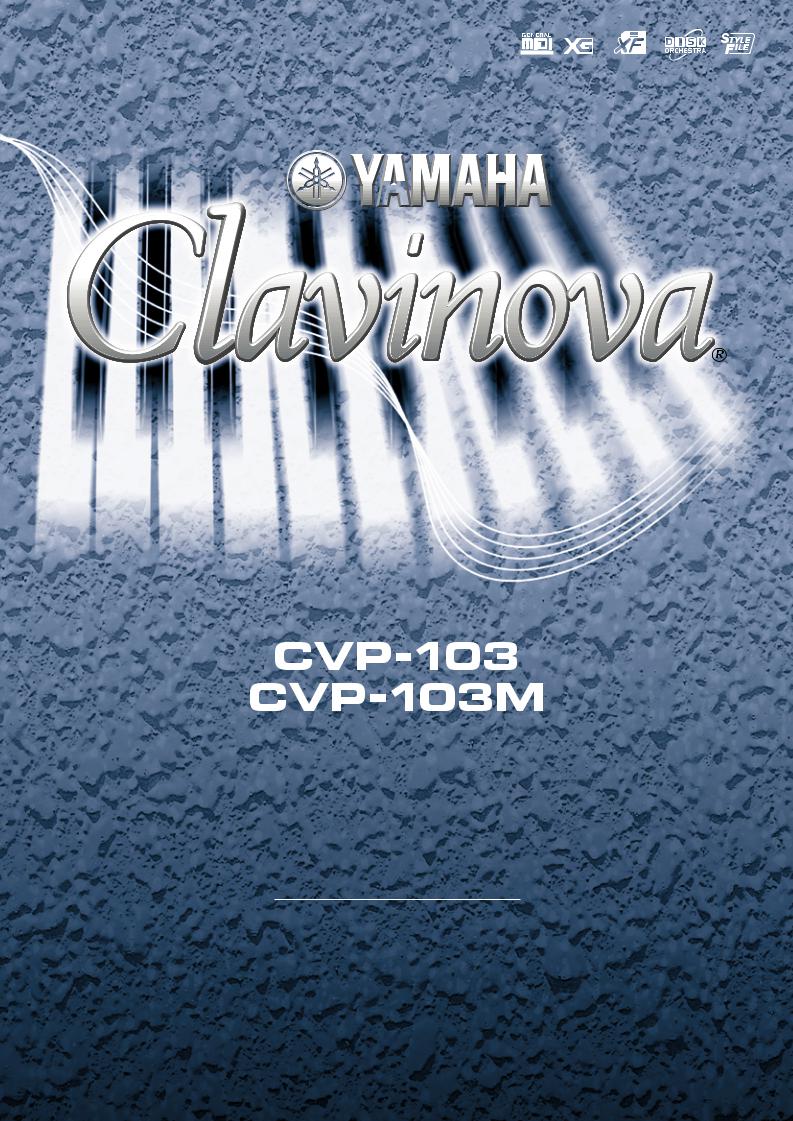
Owner’s Manual
IMPORTANT
Check Your Power Supply
Make sure that your local AC mains voltage matches the voltage specified on the name plate on the bottom panel. In some areas a voltage selector may be provided on the bottom panel of the main keyboard unit near the power cord. Make sure that the voltage selector is set for the voltage in your area. The voltage selector is set at 240V when the unit is initially shipped. To change the setting use a “minus” screwdriver to rotate the selector dial so that the correct voltage appears next to the pointer on the panel.
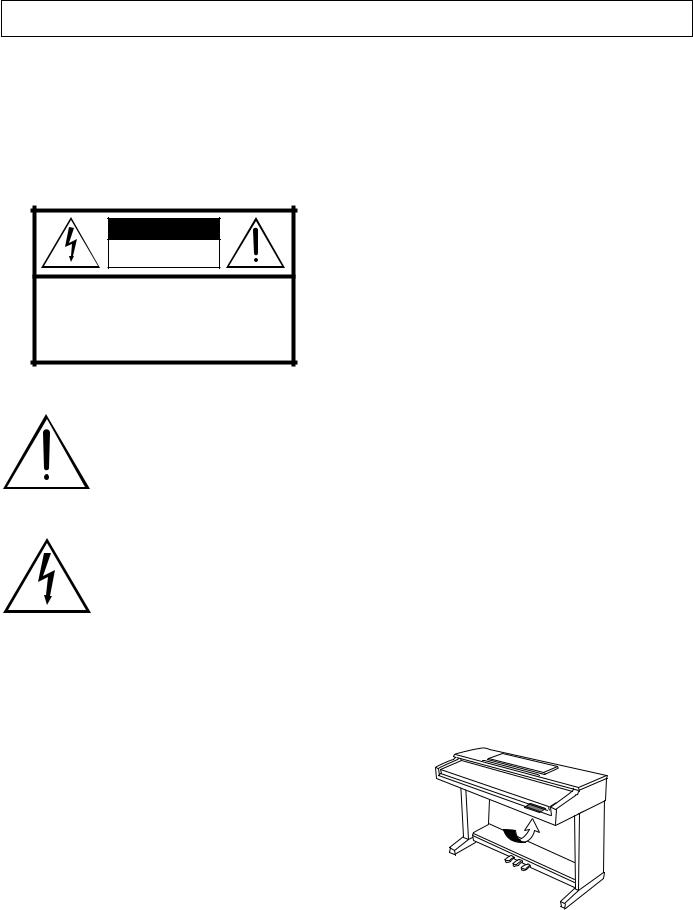
SPECIAL MESSAGE SECTION
PRODUCT SAFETY MARKINGS: Yamaha electronic products may have either labels similar to the graphics shown below or molded/stamped facsimiles of these graphics on the enclosure. The explanation of these graphics appears on this page. Please observe all cautions indicated on this page and those indicated in the safety instruction section.
CAUTION |
RISK OF ELECTRIC SHOCK |
DO NOT OPEN |
CAUTION: TO REDUCE THE RISK OF ELECTRIC SHOCK. |
DO NOT REMOVE COVER (OR BACK). |
NO USER-SERVICEABLE PARTS INSIDE. |
REFER SERVICING TO QUALIFIED SERVICE PERSONNEL. |
See bottom of Keyboard enclosure for graphic symbol markings.
The exclamation point within the equilateral triangle is intended to alert the user to the presence of important operating and maintenance (servicing) instructions in the literature accompanying the product.
The lightning flash with arrowhead symbol, within the equilateral triangle, is intended to alert the user to the presence of uninsulated “dangerous voltage” within the product’s enclosure that may be of sufficient magnitude to constitute a risk of electrical shock.
IMPORTANT NOTICE: All Yamaha electronic products are tested and approved by an independent safety testing laboratory in order that you may be sure that when it is properly installed and used in its normal and customary manner, all foreseeable risks have been eliminated. DO NOT modify this unit or commission others to do so unless specifically authorized by Yamaha. Product performance and/or safety standards may be diminished. Claims filed under the expressed warranty may be denied if the unit is/has been modified. Implied warranties may also be affected.
SPECIFICATIONS SUBJECT TO CHANGE: The information contained in this manual is believed to be correct at the time of printing. However, Yamaha reserves the right to change or modify any of the specifications without notice or obligation to update existing units.
92-469- (bottom)
ENVIRONMENTAL ISSUES: Yamaha strives to produce products that are both user safe and environmentally friendly. We sincerely believe that our products and the production methods used to produce them, meet these goals. In keeping with both the letter and the spirit of the law, we want you to be aware of the following:
Battery Notice: This product MAY contain a small nonrechargable battery which (if applicable) is soldered in place. The average life span of this type of battery is approximately five years. When replacement becomes necessary, contact a qualified service representative to perform the replacement.
Warning: Do not attempt to recharge, disassemble, or incinerate this type of battery. Keep all batteries away from children. Dispose of used batteries promptly and as regulated by applicable laws. Note: In some areas, the servicer is required by law to return the defective parts. However, you do have the option of having the servicer dispose of these parts for you.
Disposal Notice: Should this product become damaged beyond repair, or for some reason its useful life is considered to be at an end, please observe all local, state, and federal regulations that relate to the disposal of products that contain lead, batteries, plastics, etc.
NOTICE: Service charges incurred due to lack of knowledge relating to how a function or effect works (when the unit is operating as designed) are not covered by the manufacturer’s warranty, and are therefore the owners responsibility. Please study this manual carefully and consult your dealer before requesting service.
NAME PLATE LOCATION: The graphic below indicates the location of the name plate. The model number, serial number, power requirements, etc., are located on this plate. You should record the model number, serial number, and the date of purchase in the spaces provided below and retain this manual as a permanent record of your purchase.
Model _____________________________________
Serial No. __________________________________
Purchase Date ______________________________

1
PRECAUTIONS
PLEASE READ CAREFULLY BEFORE PROCEEDING
* Please keep these precautions in a safe place for future reference.
 WARNING
WARNING
Always follow the basic precautions listed below to avoid the possibility of serious injury or even death from electrical shock, short-circuiting, damages, fire or other hazards. These precautions include, but are not limited to, the following:
•Do not open the instrument or attempt to disassemble the internal parts or modify them in any way. The instrument contains no user-serviceable parts. If it should appear to be malfunctioning, discontinue use immediately and have it inspected by qualified Yamaha service personnel.
•Do not expose the instrument to rain, use it near water or in damp or wet conditions, or place containers on it containing liquids which might spill into any openings.
•If the power cord or plug becomes frayed or damaged, or if there is a sudden loss of sound during use of the instrument, or if any unusual smells or
smoke should appear to be caused by it, immediately turn off the power switch, disconnect the electric plug from the outlet, and have the instrument inspected by qualified Yamaha service personnel.
•Only use the voltage specified as correct for the instrument. The required voltage is printed on the name plate of the instrument.
•Before cleaning the instrument, always remove the electric plug from the outlet. Never insert or remove an electric plug with wet hands.
•Check the electric plug periodically and remove any dirt or dust which may have accumulated on it.
 CAUTION
CAUTION
Always follow the basic precautions listed below to avoid the possibility of physical injury to you or others, or damage to the instrument or other property. These precautions include, but are not limited to, the following:
•Do not place the power cord near heat sources such as heaters or radiators, and do not excessively bend or otherwise damage the cord, place heavy objects on it, or place it in a position where anyone could walk on, trip over, or roll anything over it.
•When removing the electric plug from the instrument or an outlet, always hold the plug itself and not the cord. Pulling by the cord can damage it.
•Do not connect the instrument to an electrical outlet using a multiple-con- nector. Doing so can result in lower sound quality, or possibly cause overheating in the outlet.
•Remove the electric plug from the outlet when the instrument is not to be used for extended periods of time, or during electrical storms.
•Before connecting the instrument to other electronic components, turn off the power for all components. Before turning the power on or off for all components, set all volume levels to minimum. Also, be sure to set the volumes of all components at their minimum levels and gradually raise the volume controls while playing the instrument to set the desired listening level.
•Do not expose the instrument to excessive dust or vibrations, or extreme cold or heat (such as in direct sunlight, near a heater, or in a car during the day) to prevent the possibility of panel disfiguration or damage to the internal components.
•Do not use the instrument near other electrical products such as televisions, radios, or speakers, since this might cause interference which can affect proper operation of the other products.
•Do not place the instrument in an unstable position where it might accidentally fall over.
•Before moving the instrument, remove all connected cables.
•When cleaning the instrument, use a soft, dry cloth. Do not use paint thinners, solvents, cleaning fluids, or chemical-impregnated wiping cloths. Also, do not place vinyl, plastic or rubber objects on the instrument, since this might discolor the panel or keyboard.
•Do not rest your weight on, or place heavy objects on the instrument, and do not use excessive force on the buttons, switches or connectors.
•If the instrument has a key cover, take care that the key cover does not pinch your fingers, and do not insert a finger or hand in the key cover gap.
•If the instrument has a key cover, never insert or drop paper or metallic or other objects between the slits of the key cover and the keyboard. If this happens, immediately turn off the power and remove the electric plug from the outlet and have the instrument inspected by qualified Yamaha service personnel.
•Do not place the instrument against a wall (allow at least 3 cm/one-inch from the wall), since this can cause inadequate air circulation, and possibly result in the instrument overheating.
•Read carefully the attached documentation explaining the assembly process. Failure to assemble the instrument in the proper sequence might result in damage to the instrument or even injury.
•Do not operate the instrument for a long period of time at a high or uncomfortable volume level, since this can cause permanent hearing loss. If you experience any hearing loss or ringing in the ears, consult a physician.
■USING THE BENCH (if included)
•Do not play carelessly with or stand on the bench. Using it as a tool or stepladder or for any other purpose might result in accident or injury.
•Only one person should sit on the bench at a time, in order to prevent the possibility of accident or injury.
•If the bench screws become loose due to extensive long-term use, tighten them periodically using the included tool.
■SAVING USER DATA
•Always save data to a floppy disk frequently, in order to help prevent the loss of important data due to a malfunction or user operating error.
Yamaha cannot be held responsible for damage caused by improper use or modifications to the instrument, or data that is lost or destroyed.
Always turn the power off when the instrument is not in use.
(1)B_EL/CL-4vari.
CVP-103 3
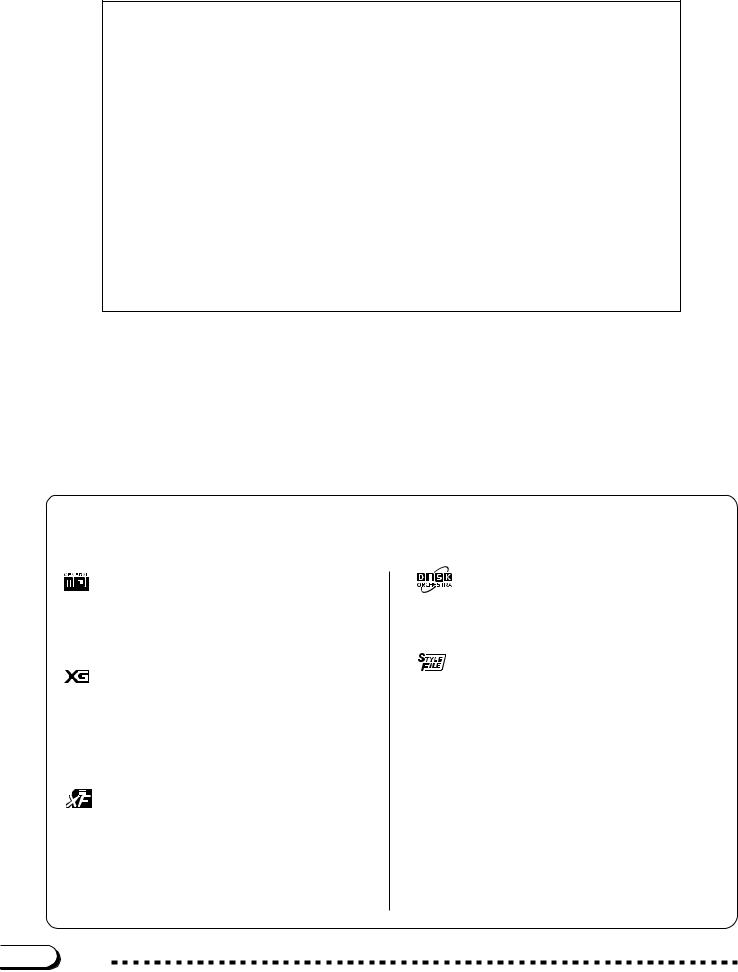
Thank you for purchasing the Yamaha Clavinova! We recommend that you read this manual carefully so that you can fully take advantage of the advanced and convenient functions of the Clavinova. We also recommend that you keep this manual in a safe and handy place for future reference.
Accessories
● Music Software Collection Disk (and Music Book)
This disk features sample songs that you can play back on your Clavinova, as well as MIDI driver software for computers.
● Floppy Disk
Use this blank disk to record your performances.
● Owner’s Manual
This manual contains complete instructions for operating your Clavinova.
● Reference Booklet
This manual contains lists of voices, styles, and parameters, etc., as well as specifications and assembly instructions for your Clavinova.
● Bench
A bench may be included or optional, depending on your locale.
•The CVP-103M will be referred to as the CVP-103 in this Owner’s Manual.
•The illustrations and LCD screens as shown in this owner’s manual are for instructional purposes only, and may appear somewhat different from those on your instrument.
•Unauthorized copying of copyrighted software for purposes other than the purchaser’s personal use is prohibited.
● Trademarks:
•Apple and Macintosh are trademarks of Apple Computer, Inc.
•IBM-PC/AT is a trademark of International Business Machines Corporation.
•Windows is the registered trademark of Microsoft® Corporation.
•All other trademarks are the property of their respective holders.
The Panel Logos
The logos printed on the Clavinova panel indicate standards/formats it supports and special features it includes.
GM System Level 1
“GM System Level 1” is an addition to the MIDI standard which guarantees that any data conforming to the standard will play accurately on any GM-compatible tone generator or synthesizer from any manufacturer.
XG Format
XG is a new Yamaha MIDI specification which significantly expands and improves on the “GM System Level 1” standard with greater voice handling capacity, expressive control, and effect capability while retaining full compatibility with GM. By using the
Clavinova’s XG voices, it is possible to record XG-compatible song files.
XF Format
The Yamaha XF format enhances the SMF (Standard MIDI File) standard with greater functionality and open-ended expandability for the future. The Clavinova is capable of displaying lyrics when an XF file containing lyric data is played. (SMF is the most common format used for MIDI sequence files. The Clavinova is compatible with SMF Formats 0 and 1, and records “song” data using
SMF Format 0.)
Disk Orchestra Collection
The DOC voice allocation format provides data playback compatibility with a wide range of Yamaha instruments and MIDI devices.
Style File Format
The Style File Format (SFF) is Yamaha’s original style file format, which uses a unique conversion system to provide highquality automatic accompaniment based on a wide range of chord types. The Clavinova uses the SFF internally, reads optional SFF style disks, and creates SFF styles using the
Custom Style feature.
4 CVP-103
2

Features of the Clavinova
● Easy-to-use LCD Display
The LCD (together with the various panel buttons) provides comprehensive and easy-to-understand control of the Clavinova’s operations (page 16).
● Wealth of Rich, Realistic Voices
The CVP-103 has a wide variety of authentic and dynamic voices, including 195 original voices, 480 XG voices, and 12 drum/SFX kits. These include exceptionally natural-sounding piano, strings and brass voices, and the particularly expressive “SweetTrumpet” voice. Moreover, you can play realistic drum and percussion sounds directly from the keyboard (page 31).
● Playback of Song Disks
The Clavinova can play back various commercially available song disks. With the appropriate disk software, you can play the piano part of the song yourself along with a full orchestra or backing band (page 93). If the software contains lyrics, you can display them on the Clavinova’s LCD.
● Special Guide Functions for Easy Learning
With the appropriate disk software, the LCD display and guide lamps help you learn songs by showing you when and where to play the proper notes. The three-step system helps you to master each song quickly and easily (page 105).
● Fun, Dynamic Automatic Accompaniment
The Auto Accompaniment of the Clavinova gives you full, exciting instrumental backing in your favorite music styles, according to the chords you play (page 57). There’s even a wide selection of “Pianist” styles that allow you to enjoy solo piano accompaniment (page 58). Choose from 160 accompaniment styles, or create your own custom styles (page 73).
● Easy Access to a Variety of Musical Enjoyment
The Clavinova offers several ways to change panel settings without a lot of fuss. You can use the One Touch Setting feature to select from four sets of voice, effect, and other settings appropriate to each accompaniment style (page 72). Or access the Music Database to choose from 463 sets of style and voice settings, selectable by title or style (page 67). You can even save your current setup for instant recall later using the handy Registration function (page 89).
● Easy-to-use Recording Features
You can record songs using a variety of methods, depending on your keyboard expertise and preference. Choose from the Quick Recording, Track Recording, and Chord Sequence Recording functions (page 110).
● Convenient TO HOST Terminals for Direct Connection to Computers
The Clavinova can be used as a high-quality sound source to play back music software for computers. It can also be used as a master keyboard, to enter performance data and create music with a computer (page 160).
3
CVP-103 5
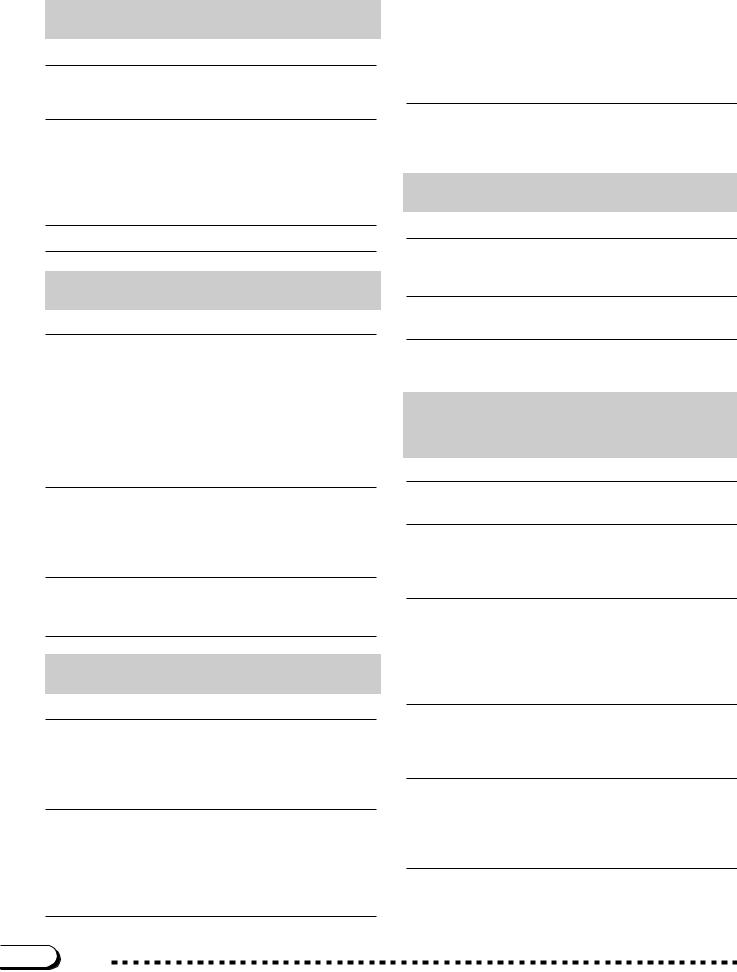
Table of Contents
CHAPTER 1: |
|
Getting Ready |
|
About This Manual |
8 |
Handling the Floppy Disk Drive (FDD) and Floppy Disks 9 |
|
Setting Up the Clavinova |
10 |
Music Stand ..................................................................................... |
10 |
Key Cover (Where Present) ............................................................. |
10 |
Turning the Power On and Off ......................................................... |
11 |
Headphones ..................................................................................... |
11 |
Other Connections ........................................................................... |
11 |
Panel Controls and Terminals |
12 |
Playing the Demo Songs |
14 |
CHAPTER 2: |
|
Basic Operation |
|
Using the LCD Display Controls |
16 |
Selecting a Function ........................................................................ |
16 |
Changing a Setting .......................................................................... |
17 |
Changing a Setting in a Menu Display ............................................. |
18 |
Displaying a Different Page ............................................................. |
19 |
Resetting a Function’s Value ........................................................... |
19 |
Using Functions in Non-rounded Rectangles .................................. |
20 |
Exiting to the Main Display ............................................................... |
21 |
Using the Direct Access Function .................................................... |
21 |
Adjusting the Volume |
23 |
Adjusting the Overall Volume ........................................................... |
23 |
Adjusting the Accompaniment or Song Volume ............................... |
23 |
Setting the Keyboard Volume .......................................................... |
23 |
Adjusting Accompaniment or Song Part Levels ............................... |
24 |
Using the Metronome |
25 |
Using the Metronome ....................................................................... |
25 |
Changing the Metronome Settings .................................................. |
26 |
Using the Help Mode |
27 |
CHAPTER 3: |
|
Voices |
|
Selecting Voices |
29 |
Selecting a Voice from the VOICE SELECT Display ....................... |
29 |
Selecting Voices from the Main Display ........................................... |
30 |
Keyboard Percussion ....................................................................... |
31 |
Changing the Keyboard Settings for the Main Voice ....................... |
31 |
Playing Two Voices Simultaneously — Dual Mode |
33 |
Selecting the Second Voice ............................................................. |
33 |
Changing the Main Voice in Dual Mode ........................................... |
33 |
Changing the Keyboard Settings for the Second Voice ................... |
34 |
Exiting the Dual Mode ...................................................................... |
35 |
Playing Two Voices on Different Sides of the Keyboard |
|
— Split Mode |
36 |
Selecting the Left Voice ................................................................... |
36 |
Changing the Main Voice in Split Mode ........................................... |
36 |
Changing the Keyboard Settings for the Left Voice ......................... |
37 |
Using the Dual and Split Functions Simultaneously ........................ |
39 |
Exiting the Split Mode ...................................................................... |
39 |
Using the Pedals |
40 |
Damper Pedal (Right) ...................................................................... |
40 |
Sostenuto Pedal (Center) ................................................................ |
40 |
Soft Pedal (Left) ............................................................................... |
40 |
CHAPTER 4: |
|
Reverb and Other Effects |
|
Reverb |
41 |
Turning the Reverb On or Off .......................................................... |
41 |
Changing the Reverb Settings ......................................................... |
41 |
Chorus |
44 |
Changing the Chorus Settings ......................................................... |
44 |
Voice Effects |
46 |
Turning the Effects On ..................................................................... |
46 |
Changing the Effect Settings ........................................................... |
46 |
CHAPTER 5: |
|
Accompaniment Styles |
|
(Rhythm and Auto Accompaniment) |
|
Selecting Accompaniment Styles |
49 |
Selecting a Style .............................................................................. |
49 |
Playing the Accompaniment Styles |
51 |
Varying the Style .............................................................................. |
51 |
Starting the Accompaniment Style ................................................... |
52 |
Stopping the Accompaniment Style ................................................. |
55 |
Playing with the Auto Accompaniment |
57 |
Using the Auto Accompaniment ....................................................... |
57 |
Starting the Auto Accompaniment ................................................... |
58 |
Stopping the Auto Accompaniment .................................................. |
58 |
Changing the Auto Accompaniment Settings .................................. |
59 |
Adjusting Individual Part Levels ....................................................... |
65 |
Other Auto Accompaniment Functions |
67 |
Music Database ............................................................................... |
67 |
Harmony .......................................................................................... |
69 |
One Touch Setting ........................................................................... |
72 |
Creating Your Own Styles |
73 |
Recording a Custom Style ............................................................... |
73 |
Other Custom Style Functions ......................................................... |
80 |
Playing Back Your Custom Styles ................................................... |
84 |
Messages in Custom Style Mode .................................................... |
84 |
Using Style Files |
86 |
About the Yamaha Style File Format ............................................... |
86 |
Loading Styles from a Disk .............................................................. |
86 |
Playing Loaded Style Files ............................................................... |
88 |
6 CVP-103
4
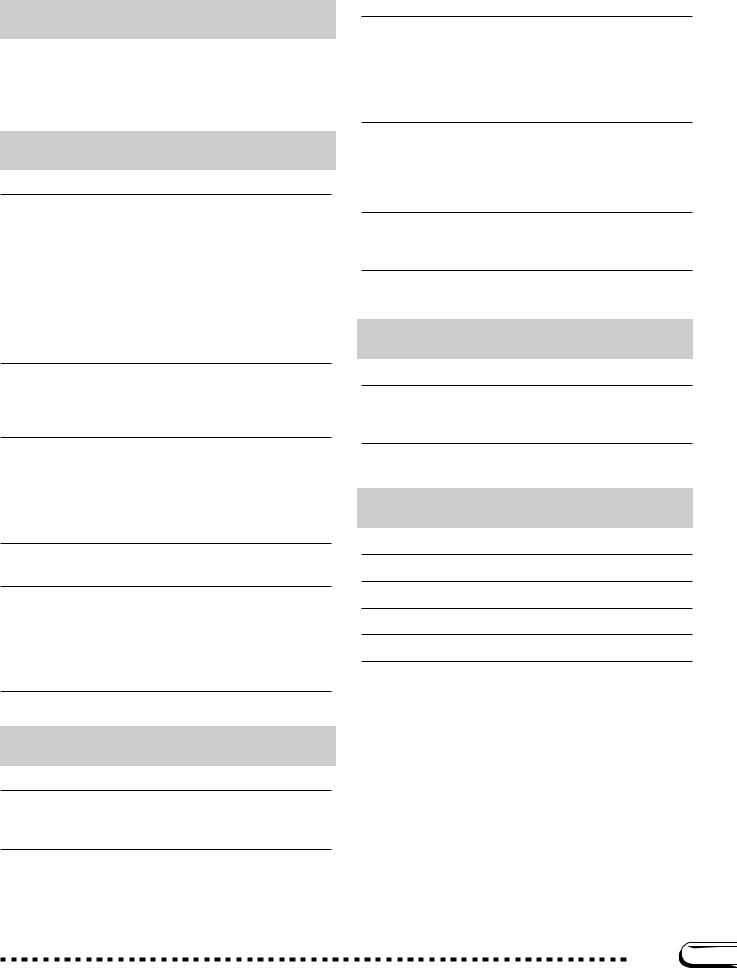
CHAPTER 6: |
|
Registrations |
|
Using Registrations(Registering and Recalling Panel Setups) |
89 |
Storing a Panel Setup ...................................................................... |
89 |
Recalling the Registered Panel Settings .......................................... |
90 |
Protecting Panel Settings ................................................................. |
91 |
CHAPTER 7: |
|
Song Control |
|
Song Playback |
93 |
Song Playback ................................................................................. |
93 |
Part Cancel ...................................................................................... |
97 |
Assignment of Tracks to 1/RIGHT and 2/LEFT, and Voice Assignment ...... |
98 |
Overall Song Playback Volume Control ........................................... |
99 |
Adjustment of Track Settings ......................................................... |
100 |
Changing Settings in the MIXER Display ....................................... |
100 |
Repeat Functions ........................................................................... |
101 |
Other Playback Controls ................................................................ |
103 |
Playing Other Types of Music Data ............................................... |
104 |
Guide Control |
105 |
Guide Methods and Piano Roll ...................................................... |
105 |
Using the Guide Function .............................................................. |
106 |
Other Guide-related Functions ....................................................... |
108 |
Song Recording |
110 |
Recording Setup: Disk Format ....................................................... |
111 |
Quick Recording ............................................................................ |
112 |
Track Recording (Multi-track Recording) ....................................... |
115 |
Adding New Tracks ........................................................................ |
118 |
Punch-in/out Recording ................................................................. |
118 |
Chord Sequence |
121 |
Other Chord Sequence Functions ................................................. |
124 |
Other Record Edit Functions |
126 |
Setup Memory ................................................................................ |
126 |
Song Name .................................................................................... |
127 |
Track Edit ....................................................................................... |
128 |
Initial Edit (Changing the Initial Data) ............................................. |
130 |
Making Settings in the INITIAL EDIT Display ................................ |
131 |
Recording Without a Disk |
133 |
About the CVP MEMORY Song ..................................................... |
133 |
CHAPTER 8: |
|
The Utility Functions |
|
Keyboard |
136 |
FUNCTION [KEYBOARD 1] Display — page 1 ............................. |
136 |
FUNCTION [KEYBOARD 2] Display — page 2 ............................. |
137 |
Pedal |
138 |
FUNCTION [PEDAL] Display — page 3 ........................................ |
138 |
Disk |
139 |
FUNCTION [DISK 1] Display — page 4 ......................................... |
139 |
FUNCTION [DISK 2] Display — page 5 ......................................... |
142 |
FUNCTION [DISK 3] Display — page 6 ......................................... |
144 |
FUNCTION [DISK 4] Display — page 7 ......................................... |
145 |
FUNCTION [DISK 5] Display — page 8 ......................................... |
146 |
MIDI |
147 |
FUNCTION [MIDI 1] Display — page 9 ......................................... |
147 |
FUNCTION [MIDI 2] Display — page 10 ....................................... |
148 |
FUNCTION [MIDI 3] Display — page 11 ....................................... |
149 |
FUNCTION [MIDI 4] Display — page 12 ....................................... |
150 |
Backup |
152 |
FUNCTION [BACKUP 1] Display — page 13 ................................ |
152 |
FUNCTION [BACKUP 2] Display — page 14 ................................ |
153 |
Utility |
154 |
FUNCTION [MICRO TUNING] Display — page 15 ....................... |
154 |
FUNCTION [SCALE TUNING] Display — page 16 ....................... |
155 |
CHAPTER 9: |
|
Connections |
|
Audio Connections |
158 |
Headphones ................................................................................... |
158 |
Audio Input and Output .................................................................. |
158 |
Data Connections |
160 |
Connecting MIDI Equipment .......................................................... |
160 |
Connecting to a Host Computer ..................................................... |
160 |
APPENDICES |
|
Effect Type Lists |
162 |
Messages |
165 |
Troubleshooting |
170 |
MIDI and Data Compatibility |
172 |
Index |
173 |
5
CVP-103 7
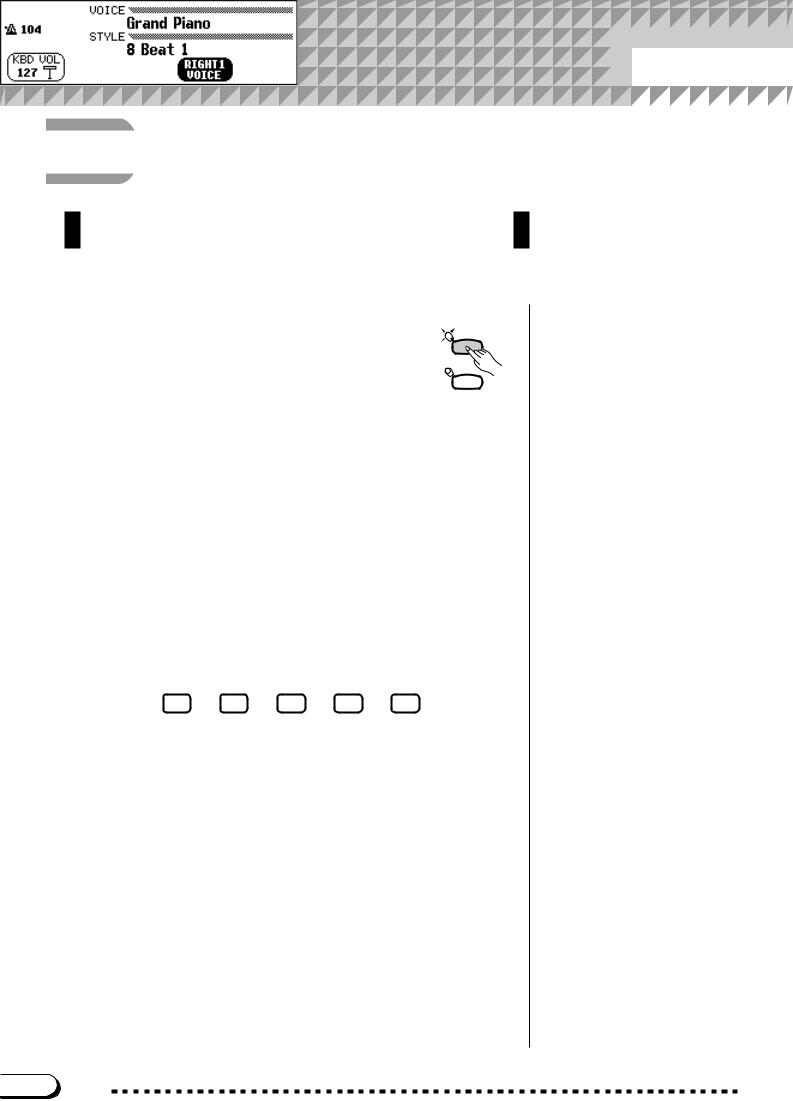
 CHAPTER 1:
CHAPTER 1:  Getting Ready
Getting Ready




 About This Manual
About This Manual
This section explains the notation conventions that are used throughout this manual.
■ Square brackets [ ] ............................................................................................
Square brackets enclose the names of panel buttons, sliders, and connectors as they appear on your Clavinova. For example, the DEMO button is expressed as [DEMO] in this manual.

 DEMO
DEMO
HELP
■ Bold characters ....................................................................................................
Bold type represents items shown in the LCD display, as well as the corresponding LCD buttons (i.e., the buttons directly below, or to the left or right of, these items). For example, the phrase “Select RIGHT1 VOICE” means that you should press the button directly below the “ RIGHT1 VOICE” label at the bottom of the display.
■ Arrows in Operation Explanations ..................................................
Different types of arrows are used to distinguish the steps of an operation from its results.
Operation steps
♥ ♣ …indicates that you should do ♥, then do ♣.
Operation results
♥ ♠ …indicates that doing ♥ results in ♠.
8 CVP-103
6
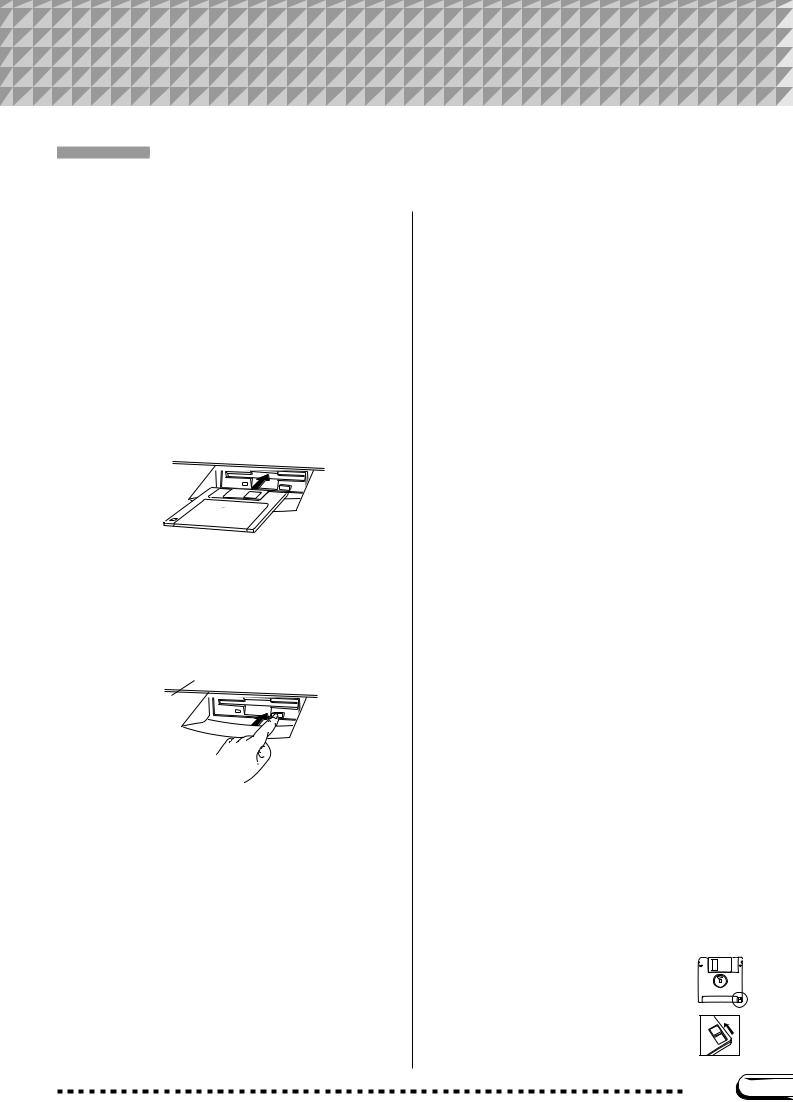
 Handling the Floppy Disk
Handling the Floppy Disk
 Drive (FDD) and Floppy Disks
Drive (FDD) and Floppy Disks
● Precautions
Be sure to handle floppy disks and treat the disk drive with care. Follow the important precautions below.
● Compatible Disk Type
3.5" 2DD and 2HD type floppy disks can be used.
■ Inserting/Ejecting Floppy Disks .............
To insert a floppy disk into the disk drive:
Hold the disk so that the label of the disk is facing upward and the sliding shutter is facing forward, towards the disk slot. Carefully insert the disk into the slot, slowly pushing it all the way in until it clicks into place and the eject button pops out.
 DISK IN USE
DISK IN USE
To eject a floppy disk:
Before ejecting the disk, be sure to confirm that the FDD is stopped (check if the [DISK IN USE] lamp is off). Press the eject button slowly as far as it will go; the disk will automatically pop out. When the disk is fully ejected, carefully remove it by hand.
DISK IN USE lamp
 DISK IN USE
DISK IN USE
Never attempt to remove the disk or turn the power off during recording, reading and playing back. Doing so can damage the disk and possibly the disk drive.
If the eject button is pressed too quickly, or if it is not pressed in as far as it will go, the disk may not eject properly. The eject button may become stuck in a half-pressed position with the disk extending from the drive slot by only a few millimeters. If this happens, do not attempt to pull out the partially ejected disk, since using force in this situation can damage the disk drive mechanism or the floppy disk. To remove a partially ejected disk, try pressing the eject button once again, or push the disk back into the slot and then repeat the eject procedure.
Be sure to remove the floppy disk from the disk drive before turning off the power. A floppy disk left in the drive for extended periods can easily pick up dust and dirt that can cause data read and write errors.
■Cleaning the Disk Drive Read/Write
Head ......................................................................................
●Clean the read/write head regularly. This instrument employs a precision magnetic read/write head which, after an extended period of use, will pick up a layer of magnetic particles from the disks used that will eventually cause read and write errors.
●To maintain the disk drive in optimum working order Yamaha recommends that you use a commerciallyavailable dry-type head cleaning disk to clean the head about once a month. Ask your Yamaha dealer about the availability of proper head-cleaning disks.
●Never open or close the key cover while a disk is extending from the drive (i.e. in the ejected position). The key cover may contact the disk,– possibily damaging the disk or even the disk drive.
●Never insert anything but floppy disks into the disk drive. Other objects may cause damage to the disk drive or floppy disks.
■About the Floppy Disks ...................................
To handle floppy disks with care:
●Do not place heavy objects on a disk or bend or apply pressure to the disk in any way. Always keep floppy disks in their protective cases when they are not in use.
●Do not expose the disk to direct sunlight, extremely high or low temperatures, or excessive humidity, dust or liquids.
●Do not open the sliding shutter and touch the exposed surface of the floppy disk inside.
●Do not expose the disk to magnetic fields, such as those produced by televisions, speakers, motors, etc., since magnetic fields can partially or completely erase data on the disk, rendering it unreadable.
●Never use a floppy disk with a deformed shutter or housing.
●Do not attach anything other than the provided labels to a floppy disk. Also make sure that labels are attached in the proper location.
To protect your data (Write-protect Tab):
To prevent accidental erasure of important data, slide the disk’s write-protect tab to the “protect” position (tab open).
Data backup
For maximum data security Yamaha recommends that you keep two copies of important data on separate floppy disks. This gives you a backup if one disk is lost or damaged. To make a backup disk use the Disk Copy function on page 142.
7
CVP-103 9
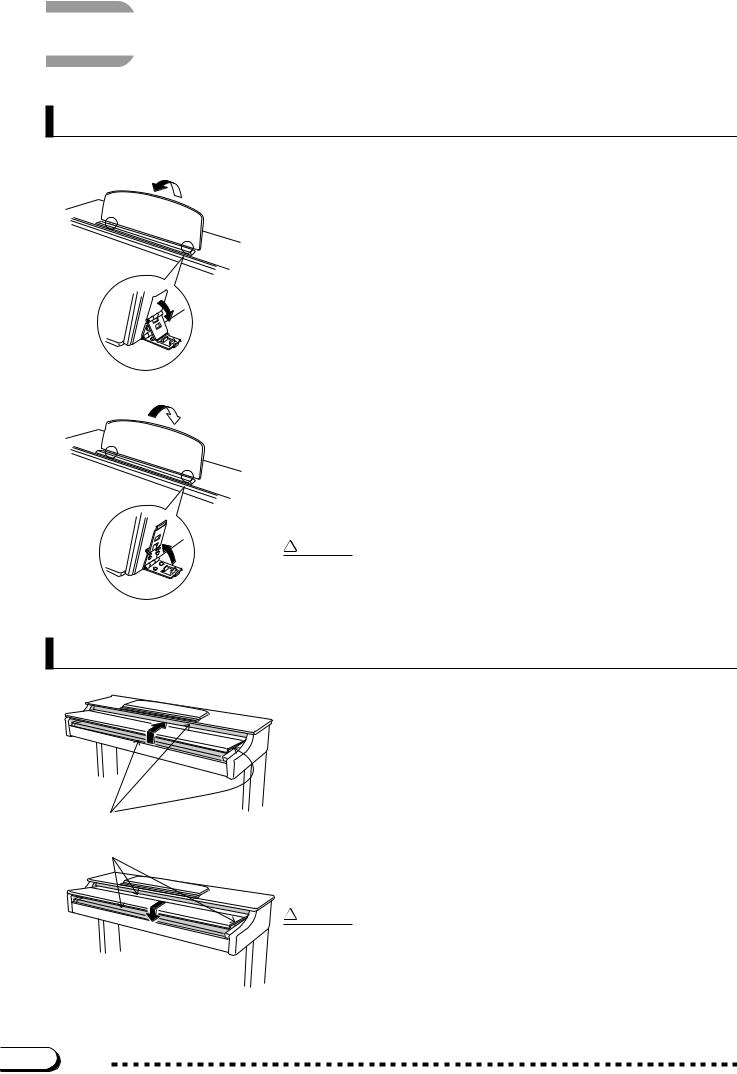
 Setting Up the Clavinova
Setting Up the Clavinova
Music Stand
■ To raise the music stand: ..........................................................................
Z Pull the stand up and toward yourself as far as it will go.
XFlip down the two metal supports at the left and the right on the rear of the music stand.
C Lower the music stand so that it rests on the metal supports.
As the illustration shows, the angle of the music stand can be set in one of three positions, according to the position of the metal supports. Set the left and right metal supports to the same position.
■ To lower the music stand: ........................................................................
Z Pull the music stand toward yourself as far as it will go.
XRaise the two metal supports until they are flat against the rear surface of the stand.
C Gently lower the music stand backward until it is all the way down.
 CAUTION
CAUTION
• Do not try to use the music stand in a half-raised position. Also, when lowering the stand, let the stand all the way down before releasing it.
Key Cover (Where Present)
Be careful to avoid catching your fingers when opening or closing the cover.
■ To open the key cover: .................................................................................
Z Lift the cover slightly (not too much).
X Slide the cover open.
■ To close the key cover: ................................................................................
Z Slide the cover toward you.
X Gently lower the cover over the keys.
 CAUTION
CAUTION
•Hold the cover with both hands when moving it, and do not release it until it is fully opened or closed. Be careful to avoid catching fingers (yours or others) between the cover and main unit.
•Do not place objects on top of the key cover. Small objects placed on the key cover may fall inside the instrument when the cover is opened, and may be impossible to remove. This could cause electric shock, short circuit, fire or other serious damage to the instrument.
10 CVP-103
8

Setting Up the Clavinova
Turning the Power On and Off
POWER
CONTRAST
ZConnect the power cord.
Insert the plugs at the ends of the cord, one into the AC INLET on the bottom panel of the Clavinova, and the other into a standard AC outlet. In some areas, a plug adapter may be provided to match the pin configuration of the AC wall outlets in your area.
XPress the [POWER] switch.
The main display appears in the LCD display. (Initially, the voice Grand Piano and the accompaniment style 8 Beat 1 are selected.) The power lamp below the lower left end of the keyboard also lights.
VOLUME
MASTER |
ACMP/SONG |
VOLUME |
VOLUME |
MAX |
MAX |
MIN MIN
CAdjust the LCD.
If the LCD is difficult to read, adjust the contrast with the [CONTRAST] knob at the left of the LCD.
V Adjust the volume.
Use the [MASTER VOLUME] slider to adjust the volume to an appropriate level.
●When you’re ready to turn off the power, press the [POWER] switch again. Both the LCD display and the power lamp below the left end of the keyboard will turn off.
Headphones
Standard stereo phone jacks
PHONES
Connect a set of stereo headphones (optional) to the [PHONES] jack. When headphones are connected, the internal speaker system is automatically shut off. Since the Clavinova has two PHONES jacks, two sets of headphones can be used simultaneously, allowing two people to enjoy listening to the performance.
Other Connections
|
|
|
|
|
MIDI |
|
|
|
|
|
|
|
IN |
OUT |
THRU |
|
|
|
AUX IN |
|
AUX OUT |
|
|
|
|
|
R |
L/L+R |
R |
L/L+R |
PEDAL |
|
HOST SELECT |
TO HOST |
|
|
|
|
|
|
|
PC-2 PC-1 |
|
|
|
|
|
|
|
|
MIDI |
Mac |
|
Your Clavinova is equipped with a variety of jacks and terminals that let you connect it to other audio and MIDI equipment. These connectors are located at the left end of the unit on the rear panel.
You can connect other instruments that you want to play through the Clavinova’s speakers to the AUX IN jacks, or output the Clavinova’s sound to external speakers using the AUX OUT jacks. Use the MIDI terminals if you want the Clavinova to control — or be controlled by — another MIDI instrument. There’s even a TO HOST terminal that lets you connect the Clavinova directly to a personal computer.
Be sure to turn the power off when connecting or disconnecting other equipment. See the instructions in Chapter 9 of this manual for details.
9
CVP-103 11
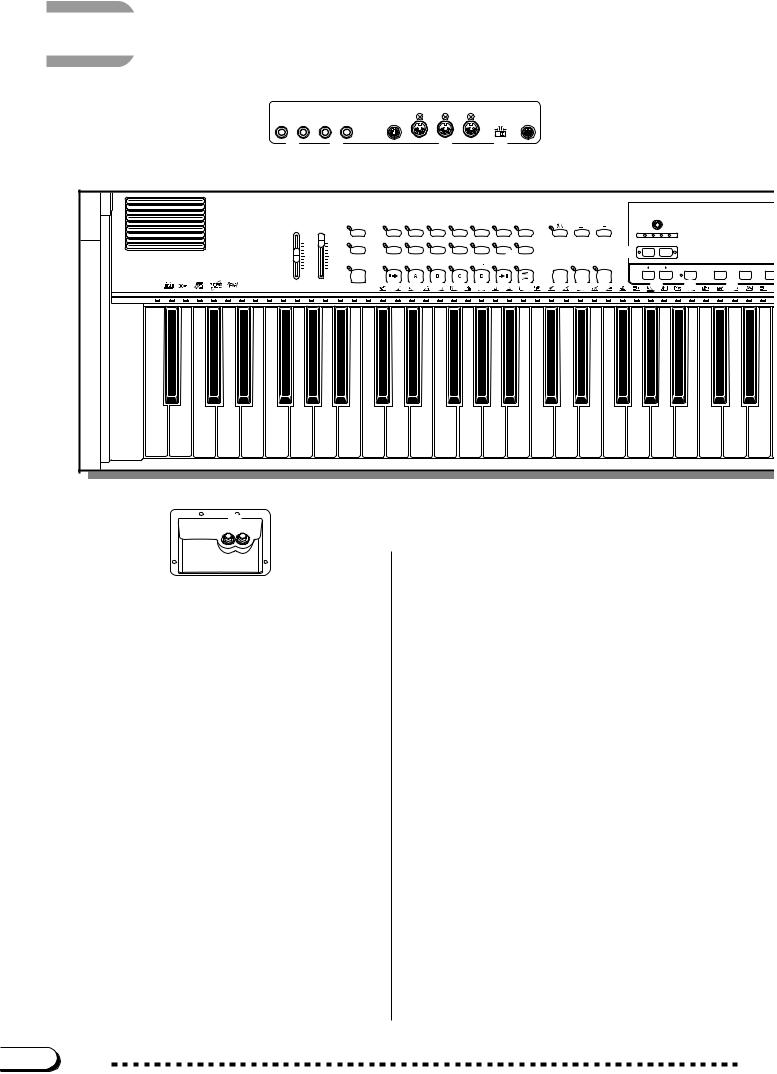
 Panel Controls and Terminals
Panel Controls and Terminals
|
|
|
|
L |
|
MIDI |
|
|
|
x |
|
AUX IN |
|
AUX OUT |
IN |
OUT |
THRU |
|
|
||
R |
L/L+R |
R |
L/L+R |
PEDAL |
|
|
|
HOST SELECT |
TO HOST |
|
|
|
|
|
|
|
|
|
PC-2 PC-1 |
|
|
|
|
|
|
|
|
|
|
MIDI |
Mac |
|
|
|
|
|
|
J |
K |
|
|
|
|
: |
|
|
z |
|
|
|
|
|
|
|
|
|
|
|
|
|
|
|
|
|
|
1 2 |
|
3 |
|
|
|
5STYLE |
|
|
7 |
|
& |
* |
|
|
|
w |
|
|
y |
|
||
|
|
|
|
|
VOLUME |
|
|
|
|
ROCK/ |
|
|
|
CONTRAST |
|
|
|
||||||||||
|
|
|
|
|
|
|
|
|
|
|
|
|
|
|
MUSIC |
|
|
|
|
|
|
|
|
|
|
|
|
|
|
|
|
|
MASTER |
ACMP/SONG |
|
DEMO |
|
8BEAT |
16BEAT |
BALLAD |
DANCE |
R&B |
PIANIST |
DATABASE |
|
TEMPO |
|
|
|
|
e |
|
|
|
|
|
|
|
|
|
VOLUME |
VOLUME |
|
|
|
|
|
|
|
|
|
|
|
|
|
|
|
BEAT |
|
|
|
|
|
|
|
|
|
|
MAX |
MAX |
|
|
|
SWING/ |
|
|
BALL- |
TRAD/ |
|
|
METRONOME |
RESET |
|
|
|
|
|
|
|
||
|
|
|
|
|
4 |
|
|
LATIN |
COUNTRY |
|
|
|
|
|
|
|
FUNCTION MIXER |
|
|
|
|
||||||
|
|
|
|
|
|
|
HELP |
|
JAZZ |
ROOM |
WALZ |
DISK |
HARMONY |
8 |
|
|
|
r |
t |
|
|
|
|||||
|
|
|
|
|
|
|
|
|
|
|
AUTO ACCOMPANIMENT |
CUSTOM6 |
START/STOP |
|
|
|
|
|
|
||||||||
|
|
|
|
|
|
|
|
|
|
|
|
AUTO FILL |
|
|
FADE |
|
|
|
|
|
|
|
|
|
|
|
|
|
|
|
|
|
MIN |
MIN |
9 |
ACMP ON |
|
INTRO |
MAIN A |
MAIN B |
MAIN C |
MAIN D |
ENDING |
IN/OUT |
|
TAP |
SYNCHRO START/STOP |
|
|
PAGE |
DIRECT ACCESS |
|
|
|
|
|
|
|
|
|
|
|
0 ! @ # $ % ^ |
|
( ) q |
|
|
u |
i |
|
o |
|
|||||||||||
CVP-103 |
|
|
|
|
|
|
|
ANCEL |
|
|
|
|
|
||||||||||||||
A-1 B-1 |
C0 |
D0 |
E0 |
F0 |
G0 |
A0 |
B0 |
C1 |
D1 |
E1 |
F1 |
G1 |
A1 |
B1 |
C2 |
D2 |
E2 |
F2 |
G2 |
A2 |
B2 |
C3 |
D3 |
E3 |
|||
H
PHONES
Volume Section |
|
|
1 |
[MASTER VOLUME] .................................... |
page 23 |
2 |
[ACMP/SONG VOLUME ] ............................ |
page 23 |
Special Mode Control Section |
|
|
3 |
[DEMO] ......................................................... |
page 14 |
4 |
[HELP] .......................................................... |
page 27 |
Accompaniment Style Section |
|
|
5STYLE buttons ............................................. |
page 49 |
|
6 |
[DISK/CUSTOM]........................................... |
page 73 |
7 |
[MUSIC DATABASE] .................................... |
page 67 |
8 |
[HARMONY] ................................................. |
page 69 |
Auto Accompaniment Section |
|
|
9 |
[ACMP ON] ................................................... |
page 57 |
0 |
[INTRO] ......................................................... |
page 54 |
![MAIN A] ....................................................... |
page 51 |
|
@[MAIN B] ....................................................... |
page 51 |
|
#[MAIN C] ....................................................... |
page 51 |
|
$[MAIN D] ....................................................... |
page 51 |
|
%[ENDING] ...................................................... |
page 55 |
|
^[FADE IN/OUT] ..................................... |
pages 55, 56 |
|
Metronome Section |
|
|
&[METRONOME] ............................................ |
page 25 |
|
*TEMPO [–], [+] ............................................. |
page 25 |
Start/Stop Section |
|
([TAP] ............................................................. |
page 53 |
)[SYNCHRO] .................................................. |
page 53 |
q[START/STOP] ...................................... |
pages 52, 55 |
Display Control Section |
|
w[CONTRAST] ................................................ |
page 11 |
e[BEAT] lamps ................................................ |
page 52 |
r[FUNCTION] ............................................... |
page 136 |
t[MIXER] ......................................................... |
page 24 |
yLCD display .................................................. |
page 16 |
uPAGE [<], [>] .............................................. |
page 19 |
i[DIRECT ACCESS] ...................................... |
page 21 |
oLCD buttons .................................................. |
page 18 |
p[EXIT] ............................................................ |
page 21 |
QData dial ....................................................... |
page 17 |
W[–], [+] ............................................................ |
page 17 |
Song Control Section |
|
E[SONG] ......................................................... |
page 94 |
R[PLAY/STOP] ................................................ |
page 95 |
T[REC] .......................................................... |
page 113 |
Y[PAUSE] ...................................................... |
page 103 |
U[REW] ......................................................... |
page 103 |
I[FF] ............................................................. |
page 103 |
12 CVP-103
10
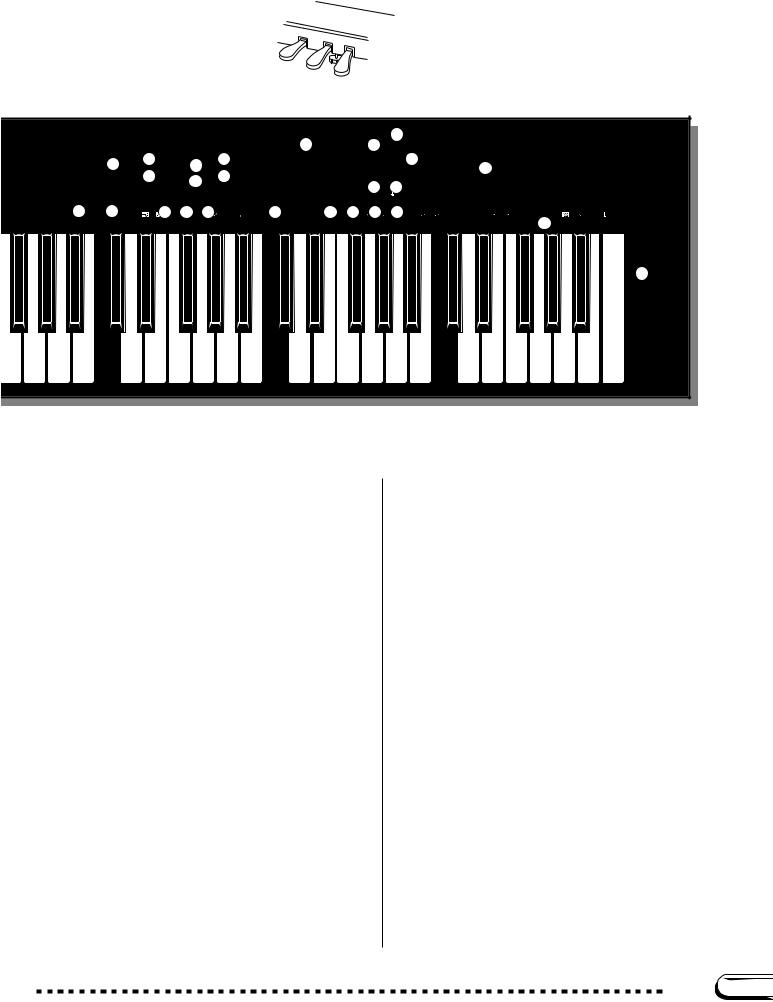
Panel Controls and Terminals
|
|
|
|
|
|
|
|
|
|
|
|
|
c |
v |
b |
|
|
|
|
|
|
|
|
|
|
|
||
|
|
|
|
|
|
|
|
|
|
|
|
|
|
|
sVOICE |
|
d |
S |
|
|
|
|
|
|
|
|
|
|
|
|
|
|
|
|
|
|
SONG CONTROL |
|
|
|
|
|
|
DISK IN USE |
|
|
|
|
|
|
|
|
|||||
|
|
|
|
|
|
|
|
PLAY/ |
|
|
|
|
|
|
SYNTHE- |
|
STRINGS/ |
|
|
|
|
|
|
|
|
|
|
|
|
|
|
|
|
|
E |
SONG |
STOP |
|
REC |
T |
PIANO |
E. PIANO |
GUITAR |
SIZER |
ORGAN |
CHOIR |
DUAL |
REVERB |
g |
|
|
|
|
|
|
|
|
|
|
|
|
Q |
|
PAUSE |
REWR FF |
BRASS |
SAX / |
BASS |
PER- |
ENSEMBLE |
XG |
SPLIT |
EFFECT |
|
|
D |
|
|
|
|
|
|||||
|
|
|
|
|
|
Y |
I |
FLUTE |
CUSSION |
|
|
|
|
|
|
|
|
|||||||||||
|
|
|
|
|
|
|
U |
|
|
|
|
|
|
fREGIST- |
hONE TOUCH |
|
|
|
|
|
|
|
|
|||||
|
|
|
|
|
|
|
|
GUIDE CONTROL |
|
|
|
REGISTRATION/ONE TOUCH SETTING |
|
|
|
|
|
|
|
|
||||||||
|
|
|
EXIT |
|
|
|
|
|
|
SOUND |
|
1 |
2 |
3 |
4 |
|
|
|
|
|
|
|
|
|
|
|||
|
|
|
|
|
|
EASY PLAY NEXT NOTE |
REPEAT |
|
BANK |
BANK |
RATION |
SETTING |
|
|
|
|
|
|
|
|
||||||||
|
|
|
|
|
|
|
|
|
|
|
|
|
|
|
|
|||||||||||||
|
|
|
p |
W |
|
|
O P a |
|
|
j |
|
k l ; A |
|
|
|
|
|
G |
|
|
|
|||||||
|
|
|
|
|
|
|
|
|
|
|
|
|
|
|
|
|
|
|
|
|
|
|
|
|
|
|
|
|
|
|
|
|
|
|
|
|
|
|
|
|
|
|
|
|
|
|
|
|
|
|
|
|
|
|
|
|
F |
|
|
|
|
|
|
|
|
|
|
|
|
|
|
|
|
|
|
|
|
|
|
|
|
|
|
|
|
POWER |
F3 |
G3 |
A3 |
B3 |
C4 |
D4 |
E4 |
F4 |
G4 |
A4 |
B4 |
C5 |
D5 |
E5 |
F5 |
G5 |
A5 |
B5 |
C6 |
D6 |
E6 |
F6 |
G6 |
A6 |
B6 |
C7 |
|||
Guide Control Section |
|
O[EASY PLAY] .............................................. |
page 105 |
P[NEXT NOTE] ............................................. |
page 105 |
a[SOUND REPEAT] ..................................... |
page 106 |
Voice Section |
|
sVOICE buttons ............................................. |
page 29 |
d[DUAL] .......................................................... |
page 33 |
f[SPLIT] .......................................................... |
page 36 |
g[REVERB] ..................................................... |
page 41 |
h[EFFECT] ...................................................... |
page 46 |
Registration/One Touch Setting Section |
|
j[1] through [4] ....................................... |
pages 72, 90 |
k[BANK –] ....................................................... |
page 89 |
l[BANK +] ....................................................... |
page 89 |
;[REGISTRATION] ......................................... |
page 90 |
A[ONE TOUCH SETTING] ............................. |
page 72 |
S[DISK IN USE] lamp ....................................... |
page 9 |
DFloppy disk drive (3.5”) .................................. |
page 9 |
F[POWER] ...................................................... |
page 11 |
GKeyboard guide lamps ............................... |
page 109 |
Connectors |
|
H[PHONES]................................................... |
page 158 |
JAUX IN [L/L+R], [R] .................................... |
page 158 |
KAUX OUT [L/L+R], [R] ................................ |
page 159 |
L[PEDAL] .............. |
page 42 in the Reference Booklet |
|
:MIDI [IN], [OUT], [THRU] ........................... |
page 160 |
|
z[HOST SELECT] ........................................ |
|
page 160 |
x[TO HOST] .................................................. |
|
page 160 |
Pedals |
|
|
cSoft pedal ..................................................... |
|
page 40 |
vSostenuto pedal ........................................... |
|
page 40 |
bDamper pedal ............................................... |
|
page 40 |
11
CVP-103 13

 Playing the Demo Songs
Playing the Demo Songs
The Clavinova features a total of 50 demo songs: 4 feature songs, 24 special pieces showcasing the voices, and 22 pieces showcasing the styles. Listen to them all and hear what the Clavinova can do.
Z Call up the Demo Play mode. ..............................................................
Press [DEMO]. The lamps of the STYLE button and VOICE button flash continuously, and the DEMO display appears.

 DEMO
DEMO
HELP
X Select the desired play mode. ............................................................
Select the desired play mode by pressing the rightmost LCD button. The following three modes are available:
ALL |
All the songs play back continuously in order, starting from the |
|
selected song. Playback continues repeatedly until stopped. |
|
|
RANDOM |
All the songs play back randomly, starting from the selected |
|
song. Playback continues repeatedly until stopped. |
|
|
SINGLE |
Only the selected song plays back. When the song is finished, |
|
playback stops automatically. |
|
|
C Select the song and start playback..............................................
When you select a song, the demo automatically starts playing in the selected play mode. There are three ways to select a demo song, as described below:
(A)To listen to one of the featured demo songs, press one of the buttons under the numbers 1 through 4 in the display.
The current song number is highlighted during playback.
•You can also start the demo playback, beginning with the first feature song, by pressing [START/STOP] or [PLAY/
STOP].
•For a complete list of the Clavinova’s demo songs, refer to page 9 of the
Reference Booklet.
14 CVP-103
12
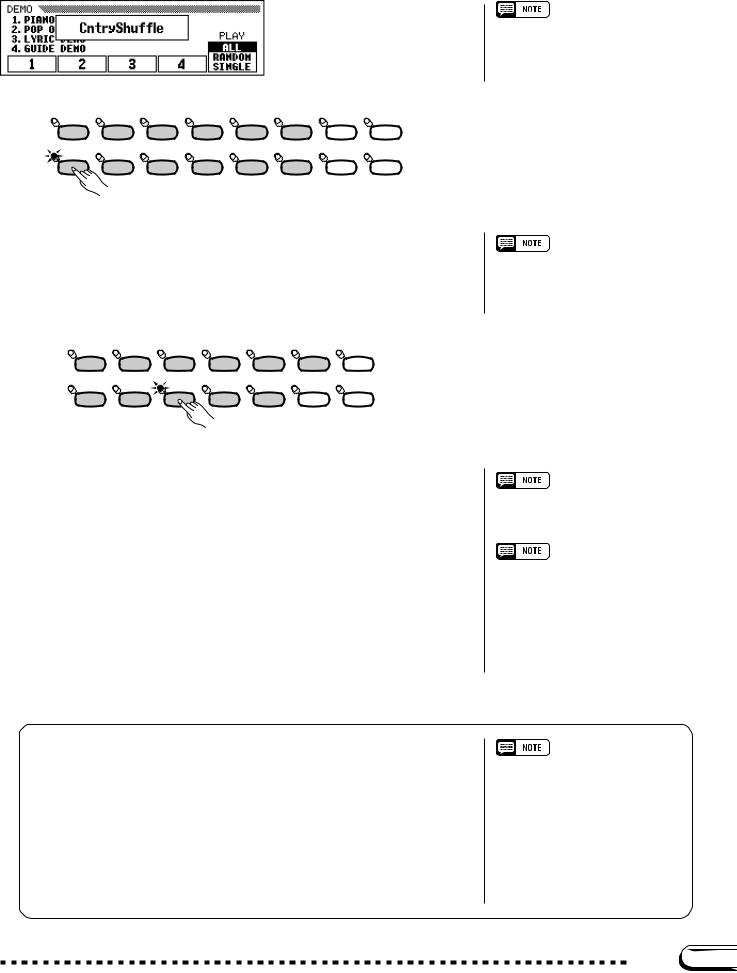
Playing the Demo Songs
(B)To listen to a voice demo, press the VOICE button corresponding to the desired voice category.
Playback starts from the first demo song for the selected category. The lamp of the corresponding VOICE button flashes.
VOICE
PIANO |
E. PIANO |
GUITAR |
SYNTHE- |
ORGAN |
STRINGS/ |
DUAL |
REVERB |
SIZER |
CHOIR |
||||||
BRASS |
SAX / |
BASS |
PER- |
ENSEMBLE |
XG |
SPLIT |
EFFECT |
FLUTE |
CUSSION |
There are two demo songs for each voice category. To skip to the second song, press the flashing button a second time.
(C)To listen to a style demo, press the STYLE button corresponding to the desired style category.
Playback starts from the first demo song for the selected category. The lamp of the corresponding STYLE button flashes.
STYLE
|
|
|
|
ROCK/ |
|
MUSIC |
8BEAT |
16BEAT |
BALLAD |
DANCE |
R&B |
PIANIST |
DATABASE |
SWING/ |
LATIN |
COUNTRY |
BALL- |
TRAD/ |
|
|
JAZZ |
ROOM |
WALZ |
DISK |
HARMONY |
||
|
|
|
|
|
CUSTOM |
|
There are two demo songs for each style category. To skip to the second song, press the flashing button a second time.
V Adjust the volume. ..........................................................................................
Use the [MASTER VOLUME] slider to adjust the volume.
B Stop the demo playback. .........................................................................
To stop playback, press either [START/STOP] or [PLAY/STOP], or the LCD button corresponding to the song that’s currently playing.
N Exit the Demo mode......................................................................................
To exit the Demo mode, press [DEMO] again (or press [EXIT]).
● Playing Along with the Demo Songs
You can play the keyboard while a demo song is playing back. You can also change the tempo (page 25) and use the [REW], [FF] and [PAUSE] buttons. When you play 3. Lyric Demo, the Clavinova will display the lyrics so you can sing (as well as play) along. Also, you can use the Guide function (page 105) while the Clavinova is playing 4. GUIDE Demo. You cannot change the voice selection while the demo is playing, however.
The [ACMP/SONG VOLUME] control cannot be used.
To change songs during playback:
Press the LCD button, VOICE button, or
STYLE button of another song; the song then changes. When ALL or RANDOM is selected as the play mode, the Clavinova will play other songs when the selected song is finished.
Demo song data is not output through the [MIDI OUT] terminal; however, your keyboard performance data is output.
13
CVP-103 15
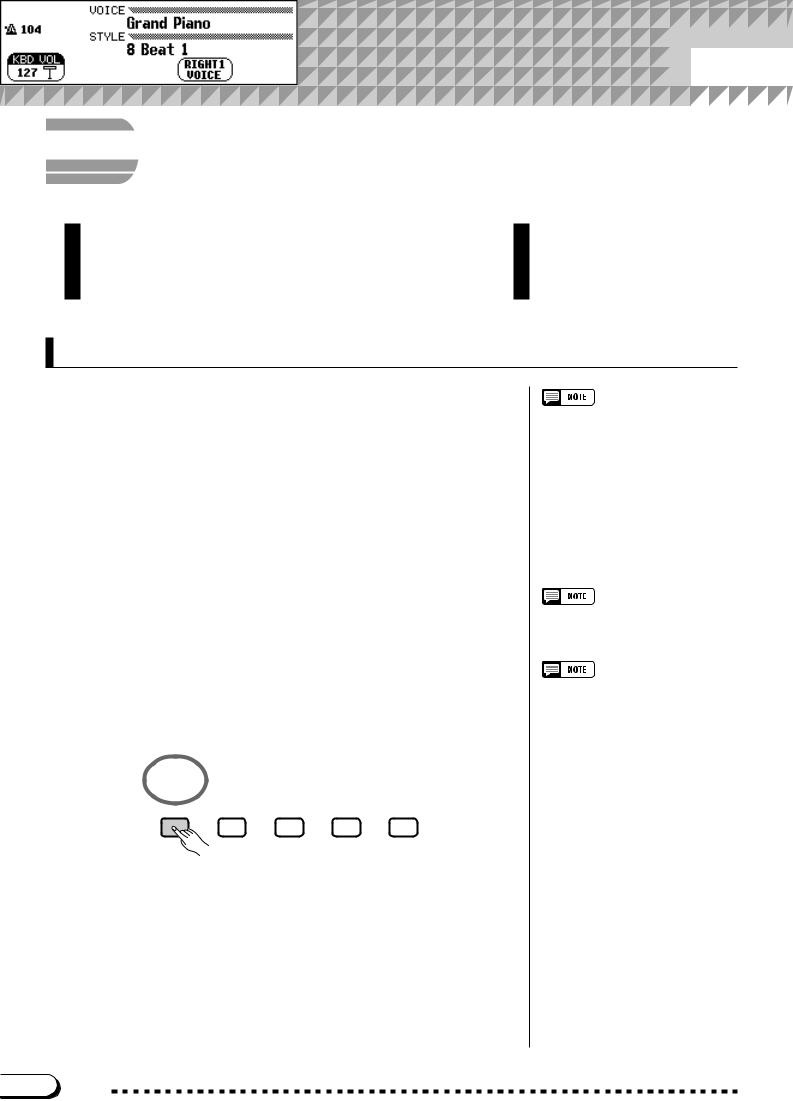
 CHAPTER
CHAPTER 2:
2: Basic Operation
Basic Operation 



 Using the LCD Display Controls
Using the LCD Display Controls
You will refer to the LCD display frequently as you operate your Clavinova. This section consists of a short tutorial that will help you learn how to read the LCD display and use the related controls.
Selecting a Function
Many of the Clavinova’s functions are displayed at the bottom of the LCD. The main display shown below contains two functions: KBD VOL and RIGHT1 VOICE. These items are displayed in rounded rectangles, which means they represent settings that can be changed.
Before you can change a function’s setting, however, you have to select it first. In the main display, the RIGHT1 VOICE function is highlighted, indicating that this function is currently selected.
To select a function, press and quickly release the LCD button directly below that function. For example, you can select KBD VOL by pressing the leftmost LCD button.
Main display
Remember, the main display is the display that appears first when you turn the power on.
Highlighted items
Selected items are highlighted (i.e., white letters on a dark background).
LCD buttons
The five LCD buttons under the LCD display represent different functions, depending on the contents of the display.
Press to select.
16 CVP-103
14
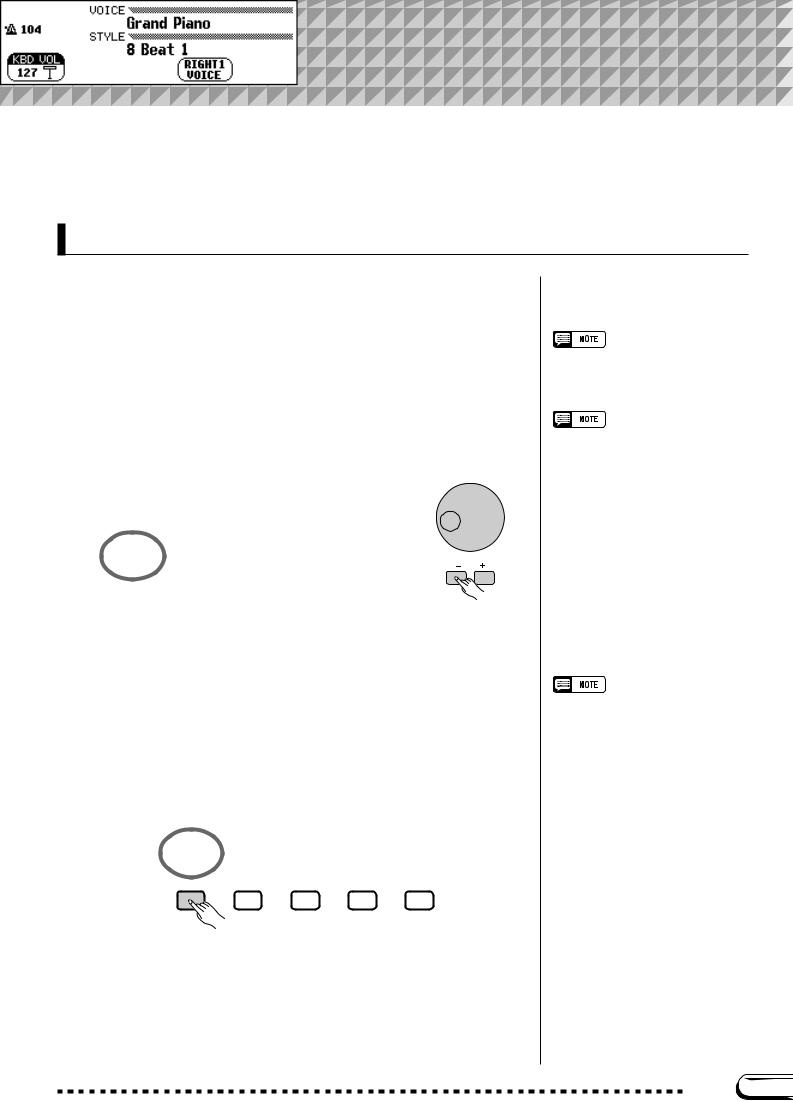
Using the LCD Display Controls
Changing a Setting
There are several ways to change a function’s value. Here are two of the main ways:
■ Using the data dial or [–] and [+] buttons.................................
Once you have selected a function, you can change its setting with the data dial or the [–]and [+] buttons. Since you have just selected KBD VOL, try turning the dial or pressing the [–]button until it reads 0.
The KBD VOL function sets the keyboard volume. When you set it to 0, you will find that the keyboard won’t produce any sound, no matter how high you set the [MASTER VOLUME] slider!
You can press the [–] and [+] buttons repeatedly to change the value a little, or hold them down to change it quickly.
Refer to page 23 for details on the KBD
VOL function.
■ Using the LCD buttons..................................................................................
You can also increase a setting by simply pressing and holding the corresponding LCD button. For now, since you’ll want to hear your keyboard later on, press and hold the leftmost LCD button until the value for KBD VOL is back up to 127.
This is why you should release the LCD button quickly when you select a function: you could end up raising its value when you want to lower it!
Hold down to increase.
Once you’ve got the keyboard volume back where it belongs, you can learn about a couple of other ways to change settings.
15
CVP-103 17

Using the LCD Display Controls
Changing a Setting in a Menu Display
You can use either of the methods described previously to change the current voice selection. Just press RIGHT1 VOICE and hold the button down, or use the data dial or the [+] button to scan through the options. Try listening to a few of the voices while you’re at it…
The problem with this method is that it can be hard to find the voice you’re looking for — after all, the Clavinova has more than 600 voices! So you’ll probably want to use a menu display to see what your choices are. Try pressing the [PIANO] button now.
Voice
A voice is one of the sounds the Clavinova uses to make music.
PIANO |
E. PIANO |
GUITAR |
SYNTHE- |
SIZER |
When you press one of the VOICE buttons, the LCD displays a new set of functions listing the voices of that type. You should now be looking at a menu of piano voices.
■ Using the LCD buttons .................................................................................................
Each piano voice in this display is listed as a separate function in a rounded rectangle. This means that you can use the LCD buttons to select voices, just like you did to select the KBD VOL and RIGHT1 VOICE functions at the beginning of this tutorial.
Press an LCD button to select the corresponding voice.
■ Using the data dial or [–] and [+] buttons................................................
There is another way to select voices in this display. You can use the data dial or the [–]and [+] buttons to change the selection. Press [–]or turn the data dial counterclockwise to select a voice to the left; press [+] or turn the dial clockwise to select a voice to the right.
Keep in mind that you can use the data dial or [–]and [+] buttons to select functions only when viewing a menu display. In other displays, these controls will change the value of the currently selected function instead.
Try selecting different piano voices in this display before you move on to the next step.
Refer to page 29 for more details about selecting voices.
Menu displays
You will use menu displays for only two purposes: to select a voice, as shown here, or to select an accompaniment style
(page 49).
Use the data dial or [–] and [+] buttons to select a voice.
18 CVP-103
16
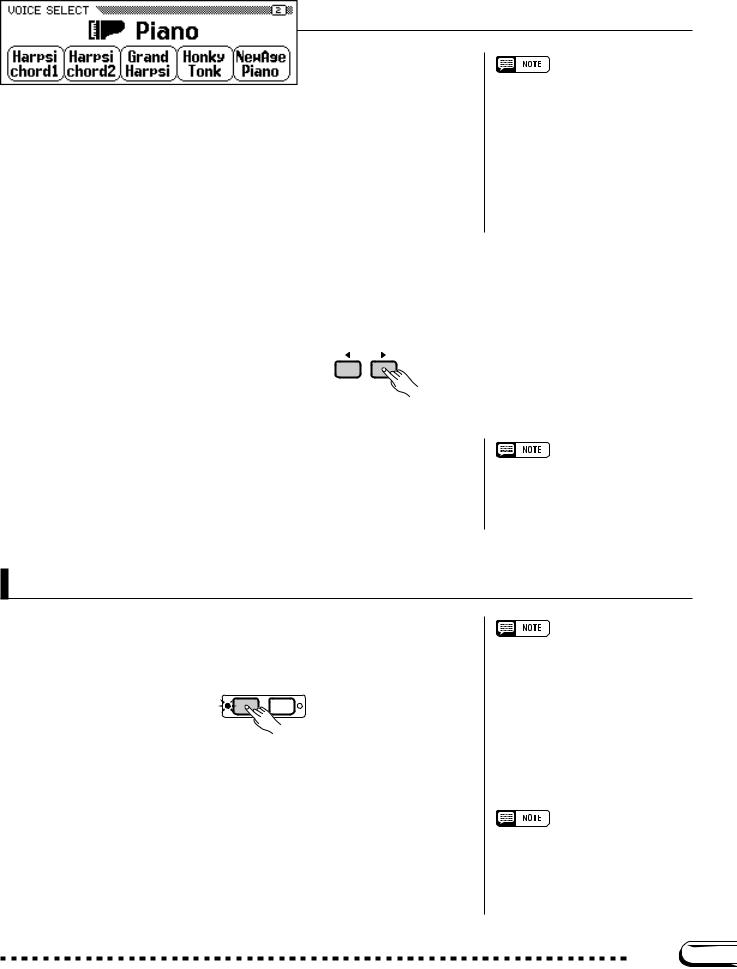
Using the LCD Display Controls
Displaying a Different Page
As you were trying out the piano voices in the preceding step, you may have been surprised to see all the voice names suddenly replaced by an entirely different set of voices. Specifically, this occurs when you select the rightmost voice in the display (Midi Grand), then turn the data dial clockwise or press the [+] button.
This happens because the CVP-103 has more piano voices than it can fit in the display. When one of the Clavinova’s features includes more functions than will fit in the display, the functions are divided among two or more display pages. The VOICE SELECT Piano display consists of two display pages, as shown below:
Display pages
Some displays are divided into two or more pages, indicated by a series of overlapping boxes in the upper right corner of the display. The number in the topmost box is the number of the current display page.
PAGE
Use the PAGE buttons to switch between pages.
When a display is divided into pages, you can use PAGE buttons to change pages. Try it: press the [<] button to see page 1, or the [>] button to see page 2. Once you have displayed the desired page, you can use the LCD buttons select a voice in that page as described in the preceding step.
Refer to page 138 for details about the functions on the FUNCTION [PEDAL] display page.
Resetting a Function’s Value
After you have changed a function’s value, you may find you want to restore its basic setting. To demonstrate this, we’ll have to look at another of the Clavinova’s displays. Press the [FUNCTION] button.
FUNCTION MIXER
This button calls up one of the Clavinova’s FUNCTION displays. You can use this display to tune and transpose the keyboard.
The TUNE function in this display corresponds to two LCD buttons labeled ▼ and ▲. You can use these buttons to tune the keyboard up or down. Press and hold the ▼ button (or use the data dial or the [–]button) to tune the keyboard down as far as it will go.
Basic settings
•The functions of the Clavinova are set to certain standard values or standard conditions when the instrument is shipped. These settings and conditions are called the basic settings.
•A function’s basic settings are generally noted in the sidebar together with the possible settings for that function.
•You can also use the Recall function (page 153) to restore basic settings at any time.
Refer to page 136 for details on the
TUNE and TRANSPOSE functions.
17
CVP-103 19
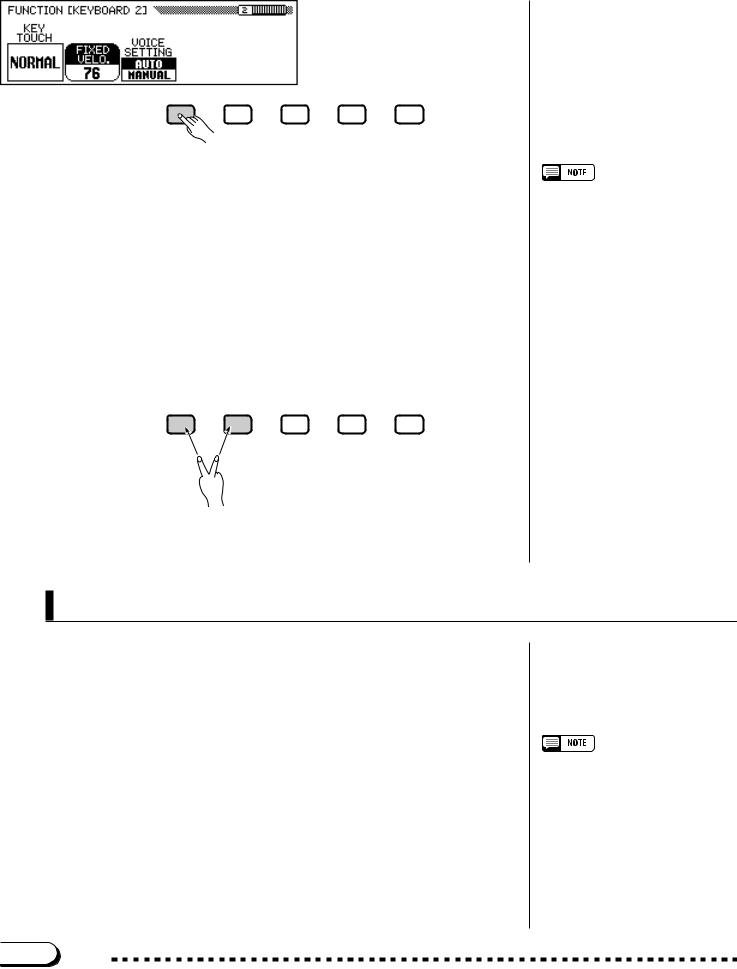
Using the LCD Display Controls
If you play a few notes, you’ll notice that your Clavinova is flat by quite a bit. Now, let’s assume that you want to reset the keyboard to the standard 440.0 Hz. You could use the ▲ button (or the data dial, or the [+] button) to return the value to its basic setting — but there’s an easier way:
When a function has a basic setting, you can reset it to that value by pressing both the ▲ and ▼ buttons (or both the [–]and [+] buttons) simultaneously. Try doing this now.
When you’ve got the keyboard back in tune, you’re ready to go on to the next operation.
There are some functions whose settings cannot be returned to the basic value by pressing the ▲ and ▼ buttons (or [–] and [+] buttons) simultaneously.
Using Functions in Non-rounded Rectangles
If you look at the upper right corner of the LCD, you’ll notice that the FUNCTION display consists of several display pages. Press the PAGE [>] key once to open the next page, which is titled FUNCTION [KEYBOARD 2]. We’ll use the functions on this page to discuss the next operation.
In addition to the FIXED VELOCITY function, which is selected in this display, the FUNCTION [KEYBOARD 2] page has two functions in normal rectangles: KEY TOUCH and VOICE SETTING. Such functions cannot be selected; instead, pressing the corresponding LCD button changes the setting directly without selecting the function.
The FIXED VELOCITY function is described on page 137.
20 CVP-103
18
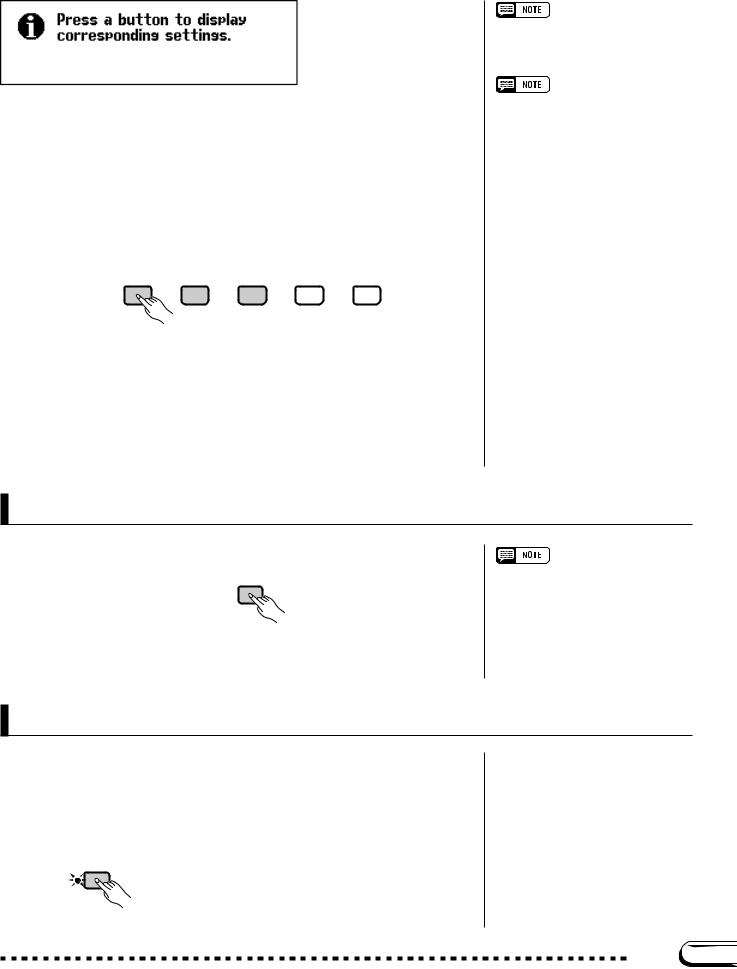
Using the LCD Display Controls
By pressing the LCD button under KEY TOUCH, for example, you can set the Clavinova’s response to how hard you play. The value displayed in the rectangle switches from NORMAL to SOFT, then FIXED, then HARD
— but the FIXED VELOCITY function remains selected.
The VOICE SETTING function determines whether reverb, chorus, effect, and other settings are automatically selected when a voice is selected. It works a little differently: when you press the LCD button, the highlighted setting switches between AUTO and MANUAL. Still, FIXED VELOCITY remains selected.
There are other sorts of functions that are displayed in non-rounded rectangles, like the ones you used to select a demo song in Demo mode (see page 14). The important thing to remember about these functions is that you don’t select them, you execute them.
Now we’re ready to return to the main display. First, however, set the
KEY TOUCH and VOICE SETTING functions back to NORMAL and
AUTO, respectively.
For more details on the KEY TOUCH function, refer to page 137.
For more details on the VOICE SETTING function, refer to page 137.
Exiting to the Main Display
To exit the current display, press the [EXIT] button.
EXIT
The main display should show the name of the last piano voice that you selected in the VOICE SELECT Piano display.
You can usually use [EXIT] to get back to the main display. In some cases, however, this button will return you to a previous setting display instead. When this happens, pressing [EXIT] again will get you back to the main display.
Using the Direct Access Function
The last function we need to discuss is Direct Access. The [DIRECT ACCESS] button lets you jump directly to pages with particularly useful settings. When you press [DIRECT ACCESS], the “ Press a button to display corresponding settings” message will appear in the LCD display.
DIRECT ACCESS
19
CVP-103 21
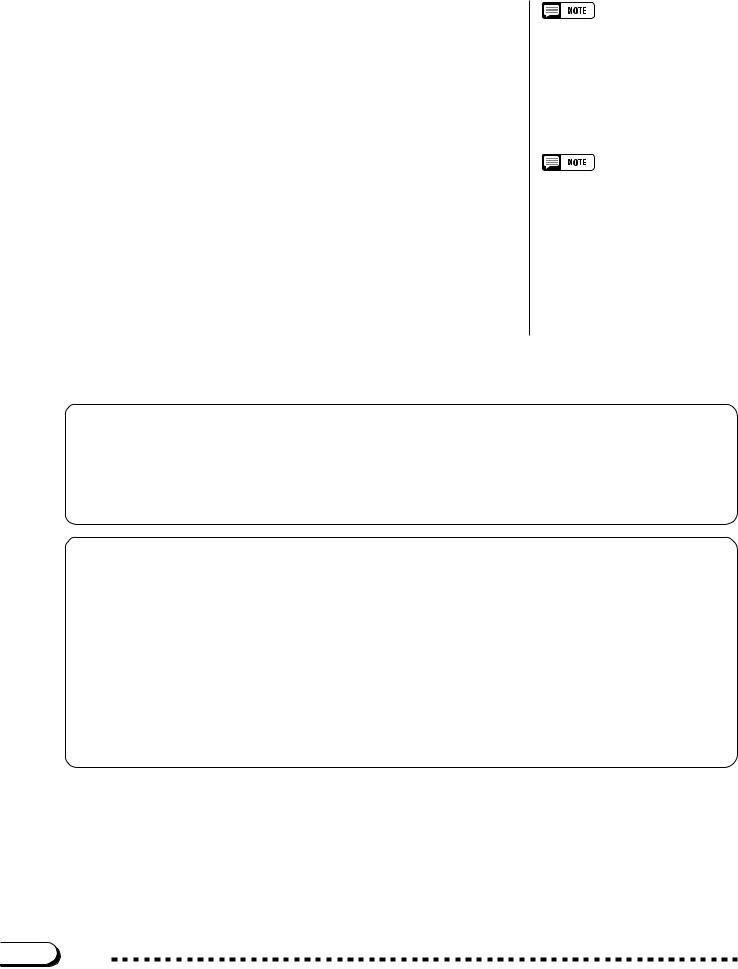
Using the LCD Display Controls
This message will remain onscreen for about three seconds. Press the button corresponding to the settings you want to display before the message disappears.
Here is a list of pages you can access with Direct Access:
[DIRECT ACCESS] plus: |
Displays: |
See page: |
|
[HARMONY] |
HARMONY |
69 |
|
[ACMP ON] |
ACCOMPANIMENT MODE |
59 |
|
[METRONOME] |
METRONOME |
26 |
|
|
KEYBOARD [RIGHT1] (1) |
31 |
|
Any VOICE button |
KEYBOARD [RIGHT2](2) |
31 |
|
|
KEYBOARD [LEFT](3) |
31 |
|
[DUAL] |
KEYBOARD [RIGHT2] |
34 |
|
[SPLIT] |
KEYBOARD [LEFT] |
37 |
|
[REVERB](4) |
REVERB |
41 |
|
REVERB DEPTH |
43 |
||
|
|||
[EFFECT](4) |
EFFECT |
46 |
|
EFFECT DEPTH |
48 |
||
|
|||
[REGISTRATION] |
REGISTRATION [FREEZE] |
91 |
|
|
|
|
You can also press an appropriate button while holding down the [DIRECT AC-
CESS] button.
(1)When RIGHT1 VOICE is selected in the main display.
(2)When RIGHT2 VOICE is selected in the main display.
(3)When LEFT VOICE is selected in the main display.
(4)Selects whichever page was most recently displayed.
● A Word about Messages
For ease of operation, the Clavinova displays various messages (like the message displayed by the Direct Access function as described above) that either prompt you to the next operation, ask for confirmation, or inform you that the last operation is not effective, valid, or appropriate. When such messages appear, follow the instructions as shown. For details about each message, please refer to the “Messages” section on page 165.
● Saving Your Changes
Now that you’ve started learning how to change the Clavinova’s settings, you may be wondering whether it will remember the changes you’ve made even after you’ve turned the power off. The answer is yes — but you need to tell it which settings you want it to remember.
By default, the Clavinova will not remember most of your setting changes. You have two ways to tell it which settings you want to remember:
•You can register your settings with the Registration function (page 89). Once you have registered your settings, you can restore them at any time by pressing a couple of buttons.
•You can instruct the Clavinova to remember certain settings when the power is off, and recall these settings when you turn the power back on. To do this, you need to change the settings of the Backup function (page 152).
22 CVP-103
20
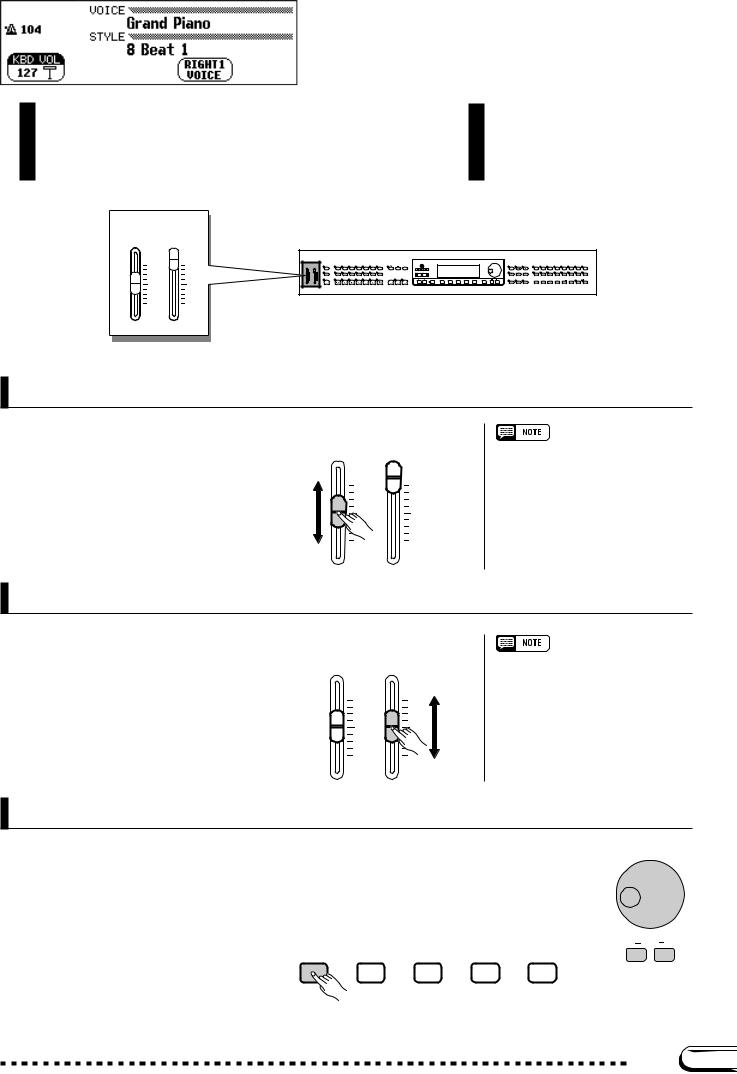
 Adjusting the Volume
Adjusting the Volume
The Clavinova has two sliders that let you adjust the overall volume and the accompaniment or song playback volume. There are also settings that you can use to adjust the keyboard volume and the volume of each part of the automatic accompaniment or song.
VOLUME
MASTER |
ACMP/SONG |
VOLUME |
VOLUME |
MAX |
MAX |
MIN |
MIN |
Adjusting the Overall Volume
Use the [MASTER VOLUME] slider to set the overall volume of the Clavinova.
VOLUME
MASTER |
ACMP/SONG |
VOLUME |
VOLUME |
MAX |
MAX |
•The [MASTER VOLUME] slider also determines the output level of the signal at the [PHONES] jack.
•Signals input to the AUX IN jacks are also affected by the [MASTER VOLUME] setting; however, signals output via the AUX OUT jacks are not.
MIN MIN
Adjusting the Accompaniment or Song Volume
Use the [ACMP/SONG VOLUME] slider to set the playback volume of the automatic accompaniment and songs.
VOLUME
MASTER |
ACMP/SONG |
VOLUME |
VOLUME |
MAX |
MAX |
This control has no effect on the volume of your keyboard performance.
MIN MIN
Setting the Keyboard Volume
Select KBD VOL in the main display, then use the data dial or the [–]and [+] buttons to change the keyboard volume.
21
CVP-103 23
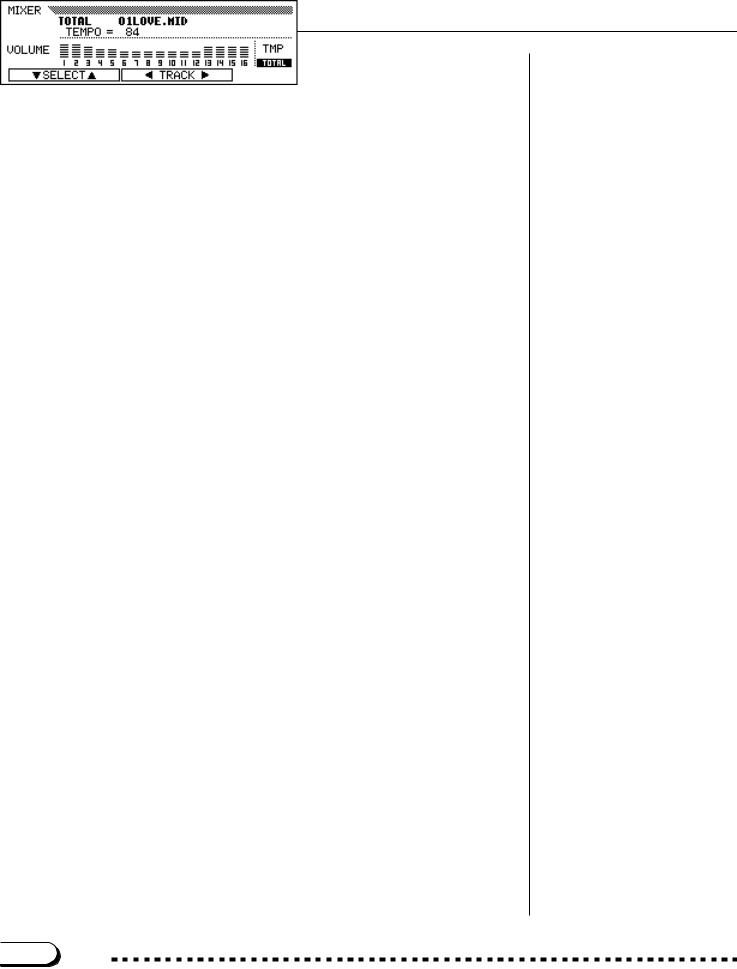
Adjusting the Volume
Adjusting Accompaniment or Song Part Levels
Call up the MIXER display by pressing [MIXER]. In the Mixer display, the volume of Automatic Accompaniment and individual parts of a song can be adjusted. Press [MIXER] again (or [EXIT]) to return to the previous display.
There are two types of mixer display, as shown below.
● Automatic Accompaniment Mixer
This MIXER display appears when you’re not using the Song mode. See “Adjusting Individual Part Levels” (page 65) for details.
● Song Mixer
This MIXER display appears in the Song mode. See “Adjusting Individual Track Levels” (page 100) for details.
24 CVP-103
22
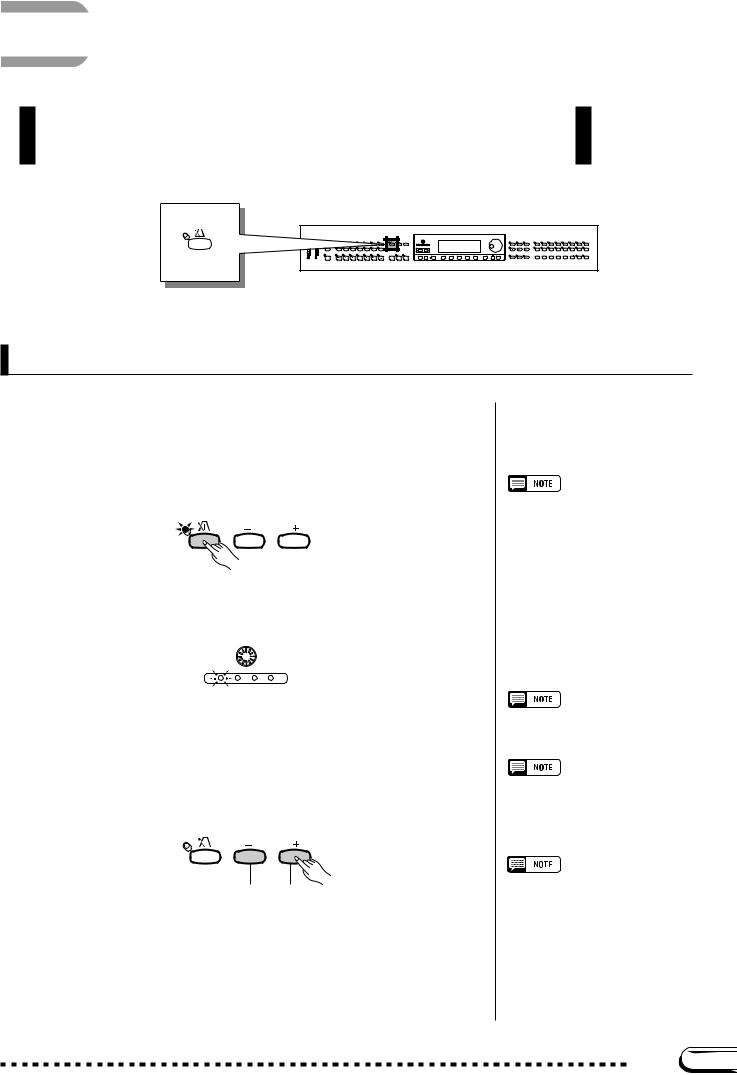
 Using the Metronome
Using the Metronome
The Clavinova features a convenient metronome that is ideal for practicing. The procedure for setting the metronome tempo can also be used to set the playback tempo for the Auto Accompaniment (page 49) and Song (page 93) modes.
METRONOME
Using the Metronome
You can start the metronome and set the tempo from any display, including the main display.
■ Starting and Stopping the Metronome .......................................
To start the metronome, simply press the [METRONOME] button.
TEMPO
METRONOME  RESET
RESET
The [METRONOME] lamp lights, and the metronome starts keeping time (indicated by the flashing of the BEAT lamps).
CONTRAST
BEAT
Press the [METRONOME] button again to stop the metronome.
■ Adjusting the Tempo ......................................................................................
The current tempo, indicated at the left edge of the display, depends on the selected style (see page 49). To change the tempo, press the TEMPO [–] and [+] buttons.
TEMPO
METRONOME  RESET
RESET
Slower Faster
The tempo indication in the main display is highlighted, and the tempo changes.
You can either press TEMPO [–]or [+] buttons briefly to change the tempo value by one, or hold down the button to change it continuously.
When the tempo is highlighted in the display, you can also use the data dial or [–]and [+] buttons to set the tempo.
•The metronome can also be used during playback in Auto Accompaniment (page 49) or Song mode
(page 93).
•The metronome cannot be used when playing disk software that was recorded in free-tempo (see page 96).
Tempo
•Range: 32 — 280
•Basic setting: Depends on style.
Restoring the Basic Tempo
You can restore the preset tempo for the currently selected style by simultaneously pressing both TEMPO [–] and [+] buttons.
During Style or Song Playback…
•If a style or song is started while the metronome is playing, the metronome will continue to sound along with the style or song.
•The metronome uses the time signature of the style or song instead of the BEAT setting during style or song playback.
•The metronome stops when the style or song stops.
23
CVP-103 25
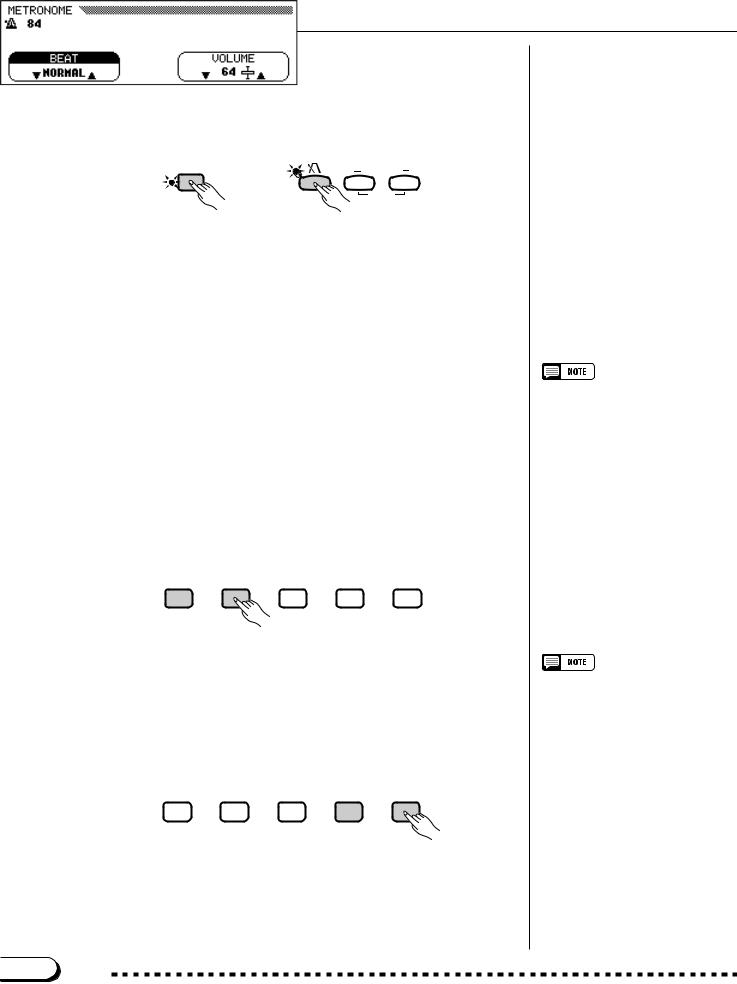
Using the Metronome
Changing the Metronome Settings
You can change the metronome’s time signature and volume using the settings in the METRONOME page.
■ Displaying the Metronome Settings ..............................................
To display the METRONOME page, press [DIRECT ACCESS], then
[METRONOME].
DIRECT ACCESS |
METRONOME |
TEMPO |
|
||
|
RESET |
The METRONOME display appears.
■ Setting the Beat (Time Signature) ....................................................
Use the BEAT ▼ and ▲ buttons to change the time signature. (If the BEAT function is highlighted, you can also change its settings with the data dial or the [–]and [+] buttons.)
When NORMAL is selected, the metronome ticks steadily at the current tempo with no accented beats.
When BEAT is set to 2, 3, 4, or 5, the metronome ticks off measures with the selected number of beats, playing a bell sound on the first beat of each measure.
■ Setting the Metronome Volume ..........................................................
Use the VOLUME▼ and ▲ buttons to change the metronome volume. (If the VOLUME function is highlighted, you can also change its settings with the data dial or the [–]and [+] buttons.)
The volume of the metronome is determined by both the VOLUME function and the [ACMP/SONG VOLUME] slider (except in Song mode, in which case the volume of the metronome is not affected by the slider). If you use the slider, the playback volume for the Automatic Accompaniment (page 50) will also be affected.
BEAT
•Settings: NORMAL, 2 — 5
•Basic setting: NORMAL
VOLUME
•Range: 0 — 127
•Basic setting: 64
26 CVP-103
24
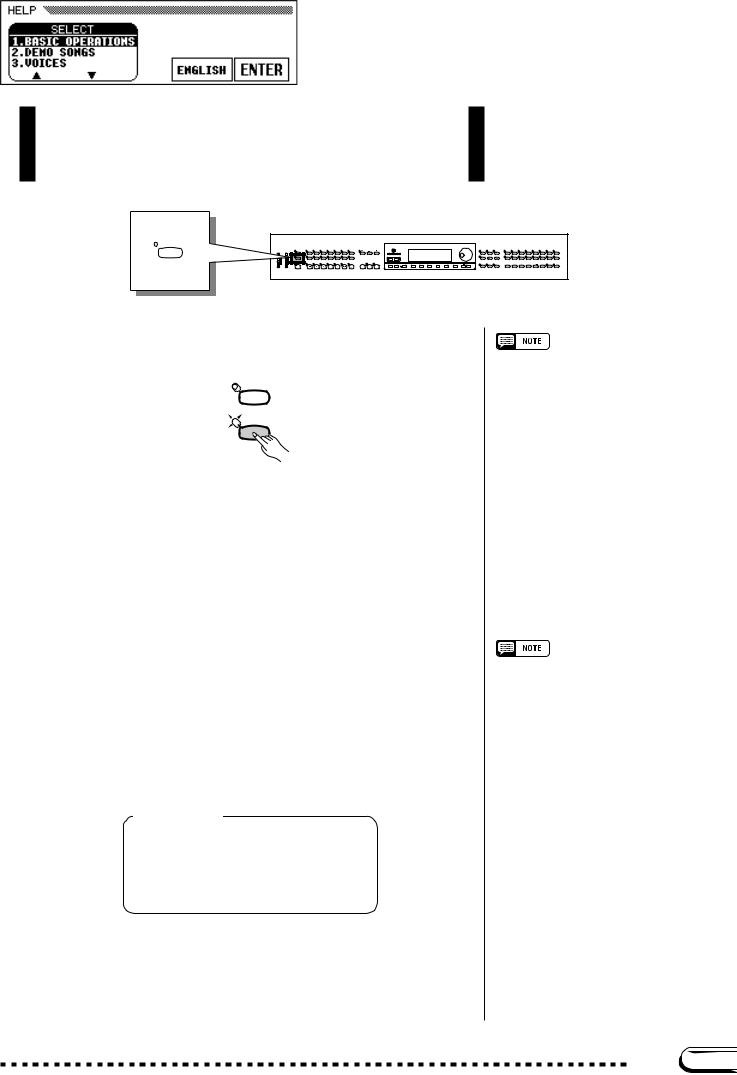
 Using the Help Mode
Using the Help Mode
The Help mode provides convenient explanations of the main functions of the Clavinova.You can select help topics from a menu displayed on the LCD, or press a button on the panel to get help information related to that control.
HELP
Z Call up the Help mode. ...............................................................................
Press the [HELP] button.
DEMO

 HELP
HELP
The Help menu display appears.
X Select the language if necessary. ...................................................
Select the desired language for help (ENGLISH, JAPANESE, GERMAN, FRENCH, or SPANISH) by pressing the fourth LCD button.
C Select a help topic. .........................................................................................
Use the SELECT ▲ and ▼ LCD buttons to select one of the following eight menu items.
Help Topics
• Basic Operations |
• Accompaniment |
• Demo Songs |
• Song Playback |
• Voices |
• Song Recording |
• Styles |
• Functions |
The selected menu is highlighted.
Press the LCD button under ENTER to enter your selection.The first page of the selected help information is displayed.
While the Help mode is active, no other operations can be performed.
The selected language is always backed up even after the power is turned off.
25
CVP-103 27
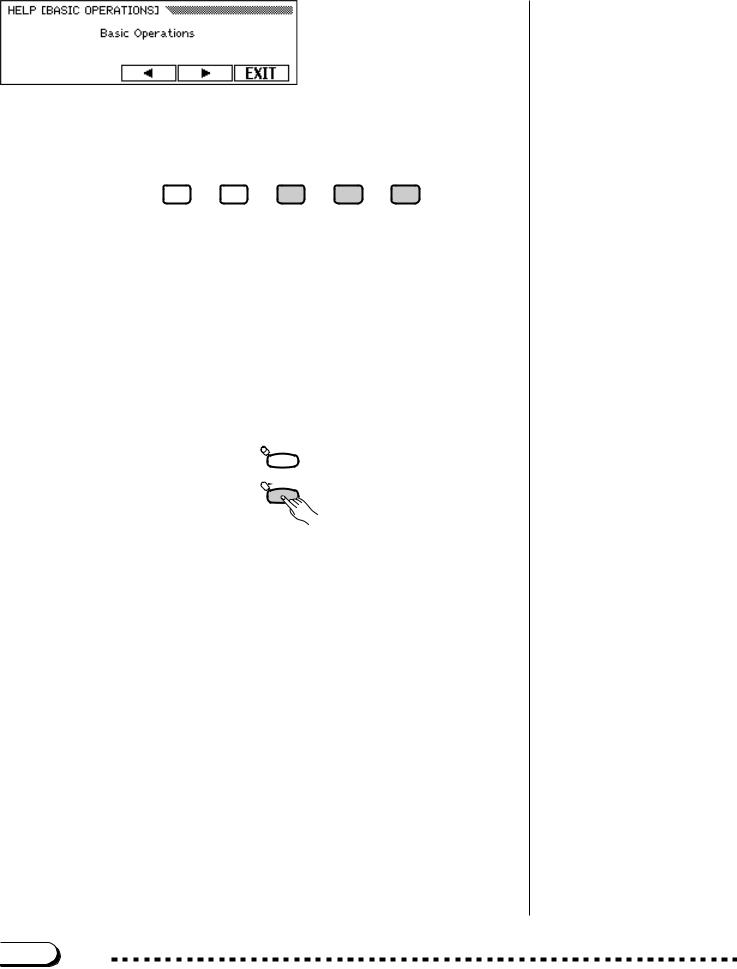
Using the Help Mode
V Turn the pages and read the help information. ................
Use the fourth LCD button to advance the page. You can also press the third LCD button if you want to go back and read the previous page.
B Exit the Help topic. ..........................................................................................
Press the LCD button under EXIT to return to the Help menu. You can select another menu item or panel button and read through other help topics.
N Exit the Help mode. ........................................................................................
To exit the Help mode and to go back to the main display at any time, simply press [HELP].
DEMO
 HELP
HELP
28 CVP-103
26

 CHAPTER 3:
CHAPTER 3: Voices
Voices








 Selecting Voices
Selecting Voices
The Clavinova features a wealth of rich, authentic voices, including piano, strings and brass instruments. It also features a Keyboard Percussion function that lets you play the realistic drum and percussion sounds directly from the keyboard.
VOICE
PIANO |
E. PIANO |
GUITAR |
SYNTHE- |
ORGAN |
STRINGS/ |
DUAL |
REVERB |
SIZER |
CHOIR |
||||||
BRASS |
SAX / |
BASS |
PER- |
ENSEMBLE |
XG |
SPLIT |
EFFECT |
FLUTE |
CUSSION |
●Voice Types
•Clavinova Voices :195
•XG Voices : 480
•Drum/SFX Kits : 12
*For a list of the voices, see page 5 in the Reference Booklet.
*The Clavinova’s voices are divided into twelve groups, corresponding to the twelve VOICE buttons on the panel.
Selecting a Voice from the VOICE SELECT Display
ZSelect the voice group. ............................................................................
Select the desired voice group by pressing the appropriate VOICE button.
The VOICE SELECT display appears.
VOICE
PIANO |
E. PIANO |
GUITAR |
SYNTHE- |
ORGAN |
STRINGS/ |
DUAL |
REVERB |
SIZER |
CHOIR |
||||||
BRASS |
SAX / |
BASS |
PER- |
ENSEMBLE |
XG |
SPLIT |
EFFECT |
FLUTE |
CUSSION |
Exiting the Display
To return to the main display, press [EXIT].
Backing Up the Selected Voice
•When the power is turned ON, the Grand Piano voice is selected automatically.
However, if the Backup function (page
152)is set to ON, the last selected voice will automatically be selected.
•The last selected voice in each group can be retained in memory, even after turning off the power, when the Backup function
(page 152) is set to ON.
27
CVP-103 29
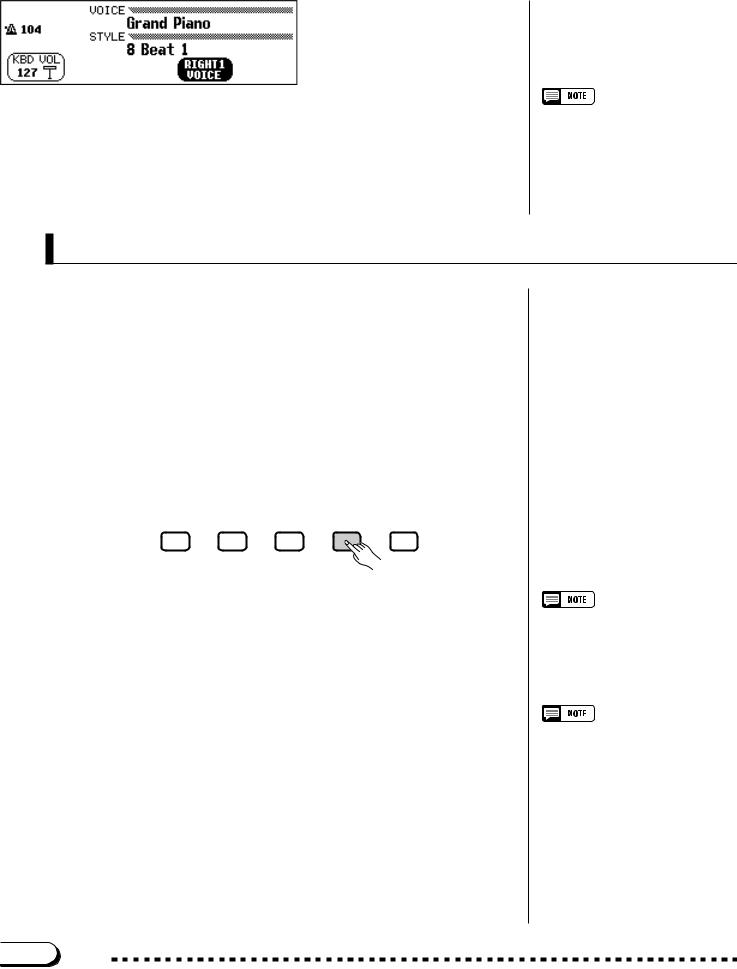
Selecting Voices
XSelect the voice. .................................................................................................
Select the desired voice by pressing the appropriate LCD button. The data dial and [–]and [+] buttons can be also used.
Each VOICE SELECT display consists of two or more pages. Use the PAGE [<] and [>] buttons to call up the various pages.
CPlay the selected voice. .............................................................................
Adjust the volume by using the [MASTER VOLUME] slider.
Automatic Voice-related Settings
Selecting a voice automatically selects the best-suited reverb, chorus, effect, and other settings for that particular voice. You can disable this so that settings are not automatically selected by using the VOICE SETTING function (page 137).
Selecting Voices from the Main Display
You can also select a voice using the RIGHT1 VOICE function in the main display.
ZSelect the RIGHT1 VOICE function. ..............................................
If the RIGHT1 VOICE function is not already highlighted, press the fourth LCD button to highlight it.
XSelect the voice. ..................................................................................................
Select the voice using the data dial or [–]and [+] buttons. You can also hold down RIGHT1 VOICE to advance the voice selection continuously. (When selecting a voice in this way, the voice can be selected not only from a certain voice group but from all voices.)
CPlay the voice. .......................................................................................................
Adjust the volume by using the [MASTER VOLUME] slider.
About Ensemble Voices
The Clavinova’s ensemble voices are rich, dual-like voices that you can play without entering the Dual mode (page 33.) Press the [Ensemble] button to display a menu of ensemble voices.
About XG Voices
Yamaha’s XG format is a major new enhancement to the GM (General MIDI) System Level 1 format. It provides for more instrument sounds and variations, as well as greater expressive control over voices and effects. XG also ensures compatibility with future instruments and software.
•Press the [XG] button to display a menu of XG voices.
•Press another VOICE button while holding down the [XG] button to display a list of XG voices in the corresponding category.
30 CVP-103
28
